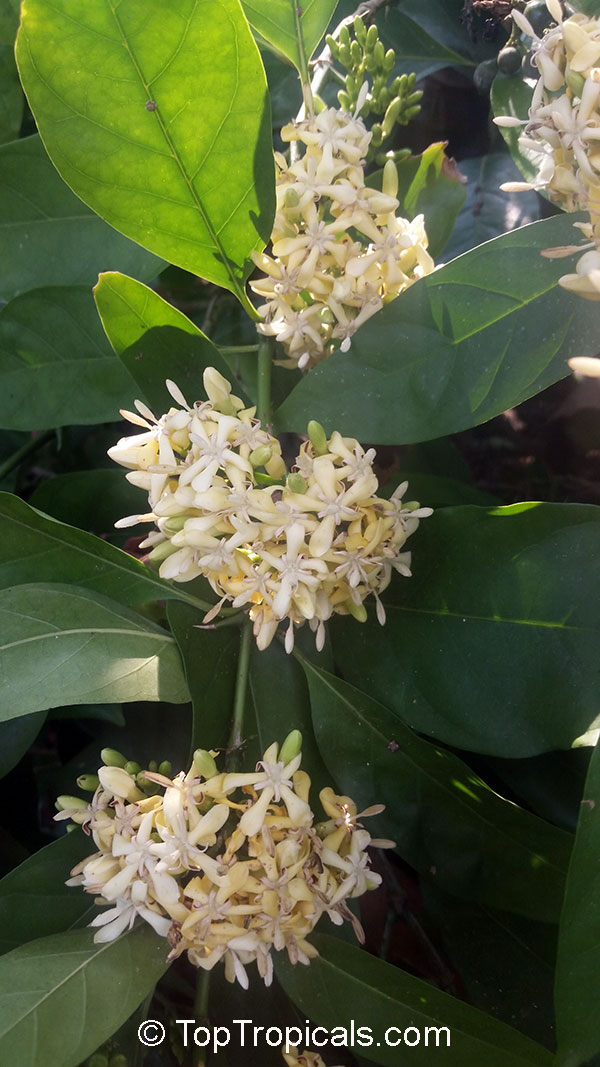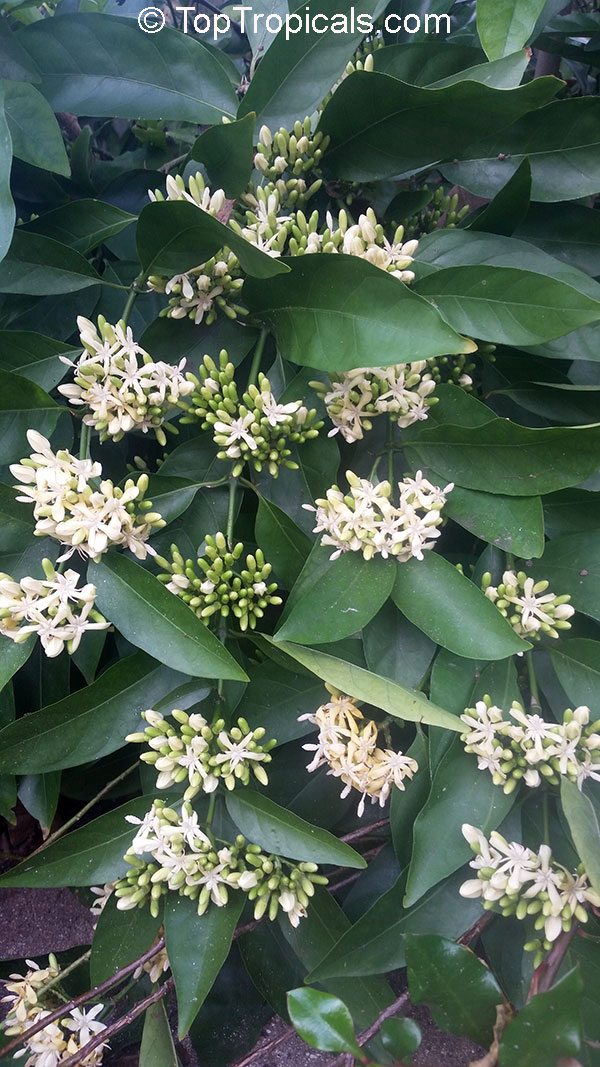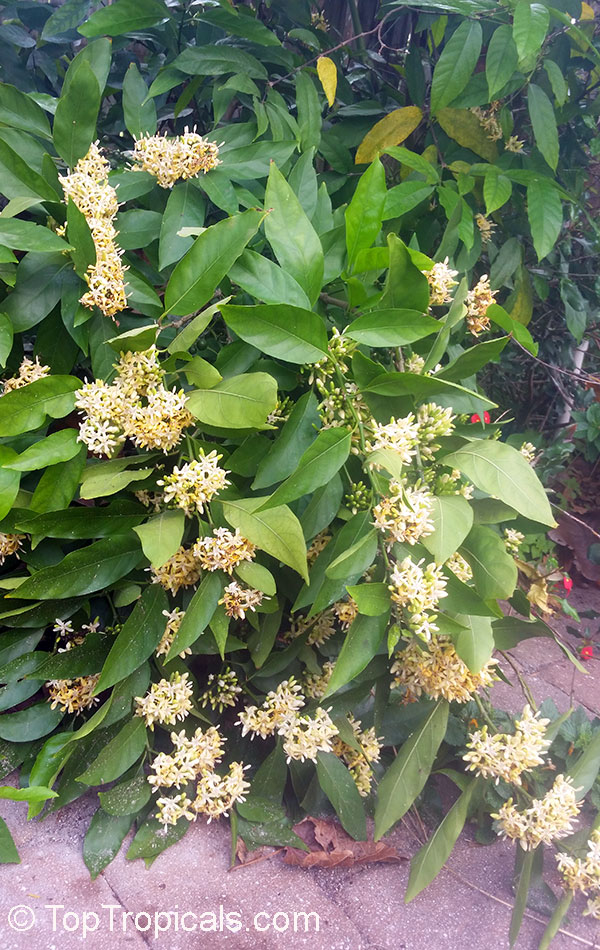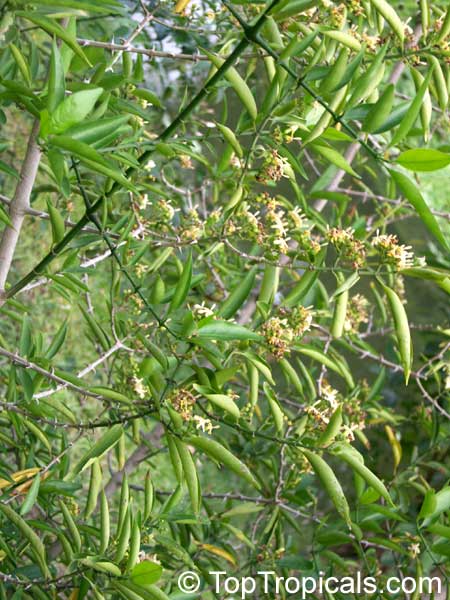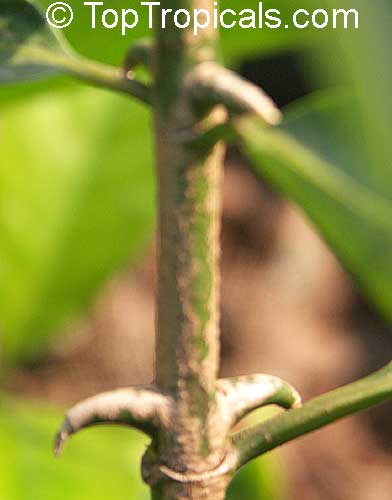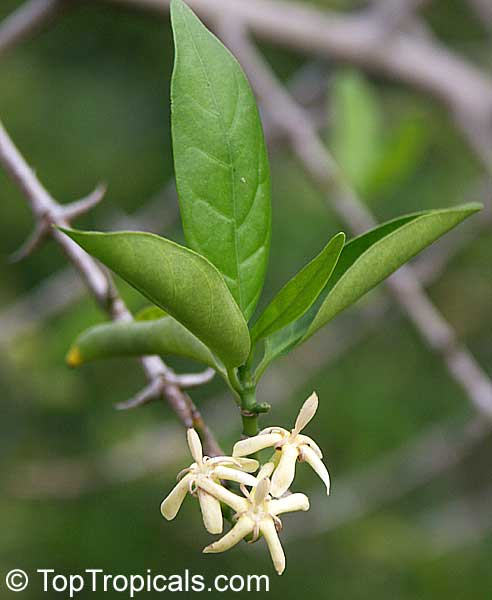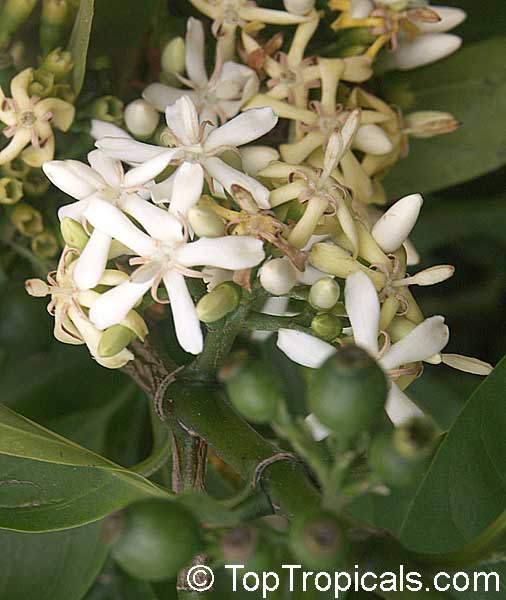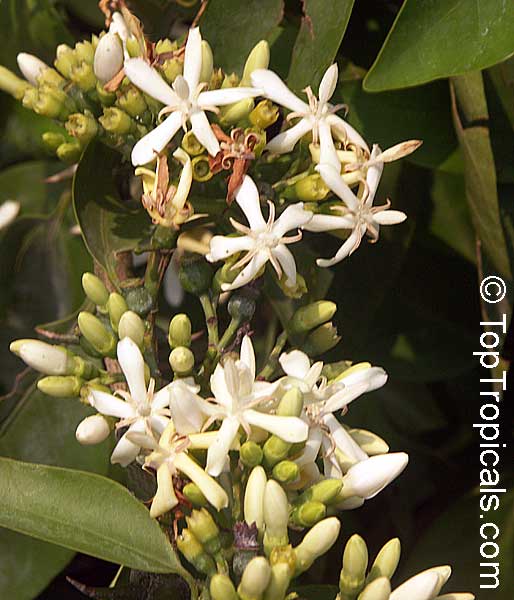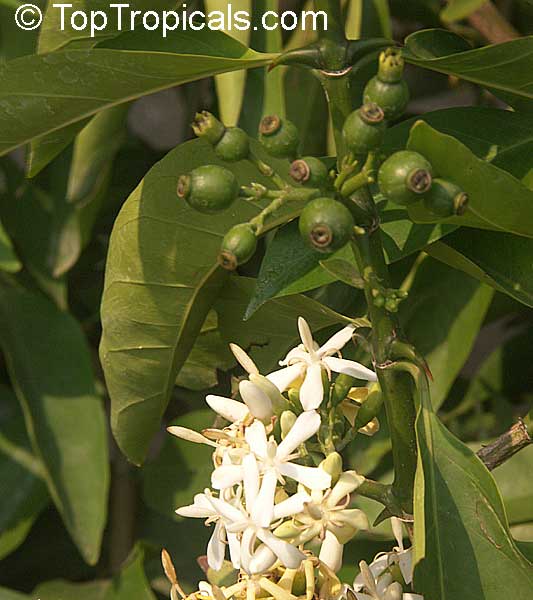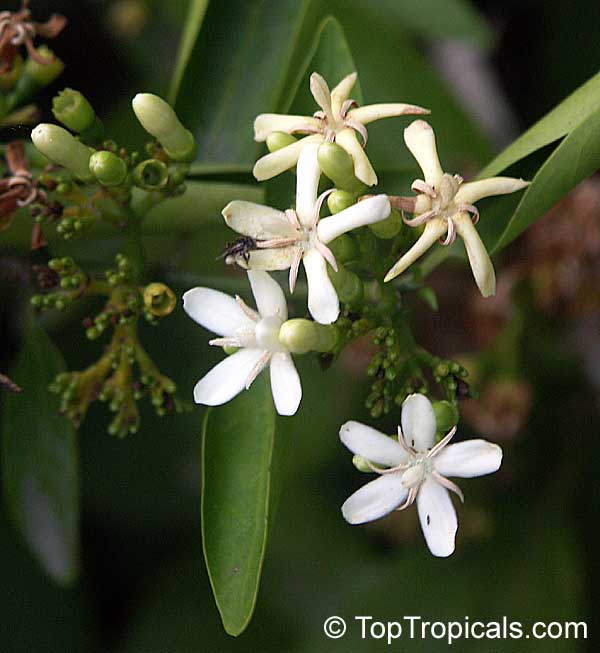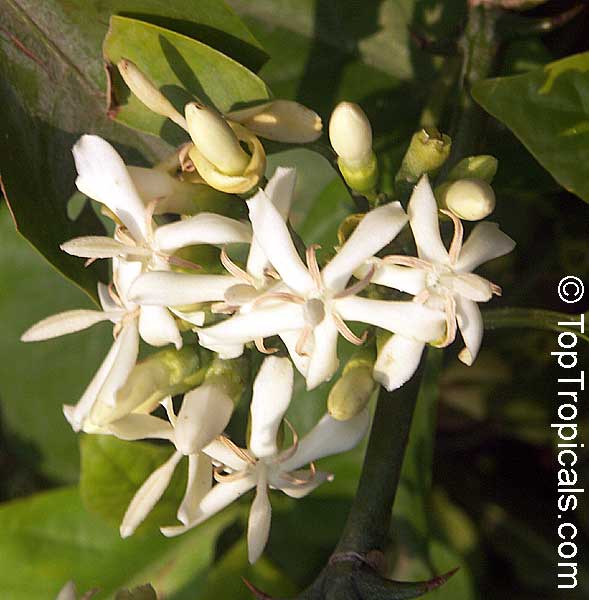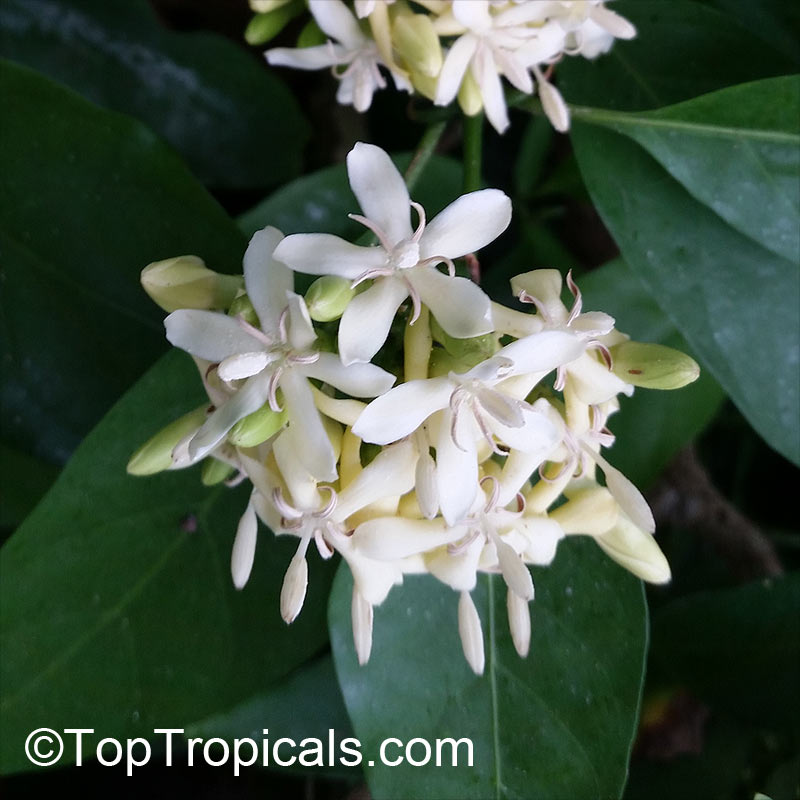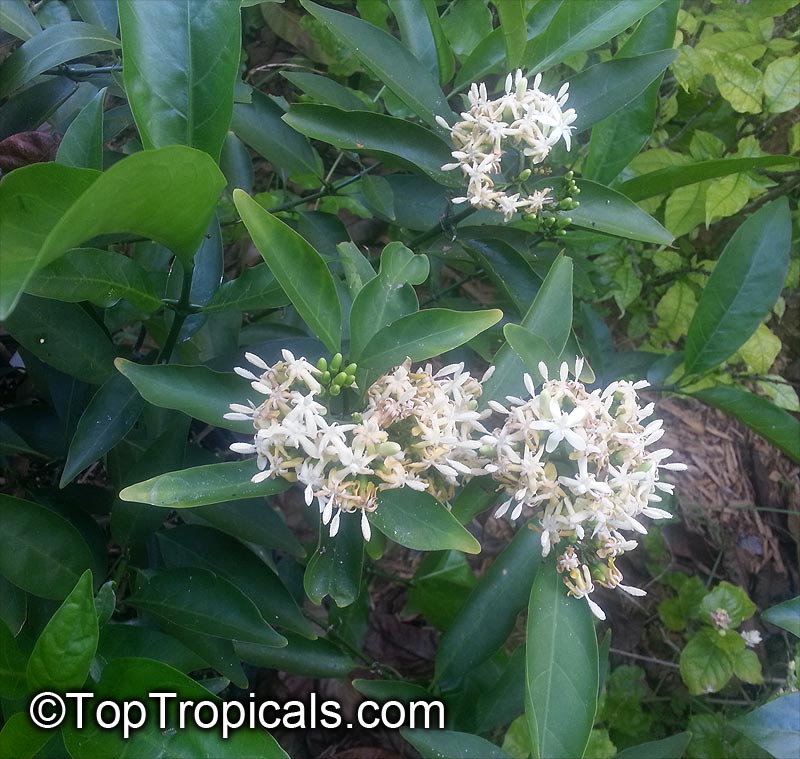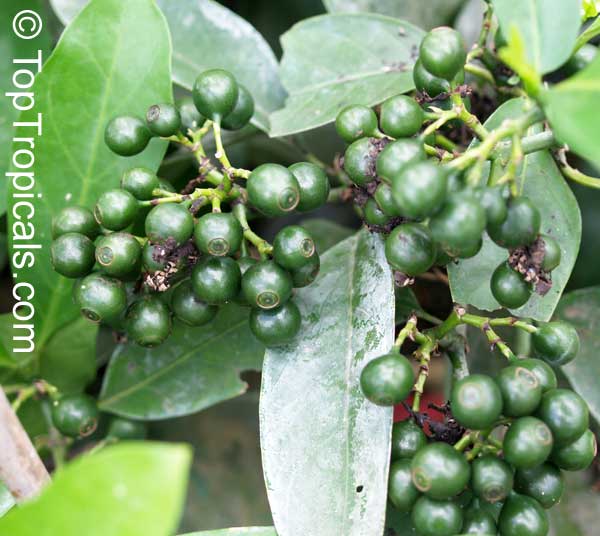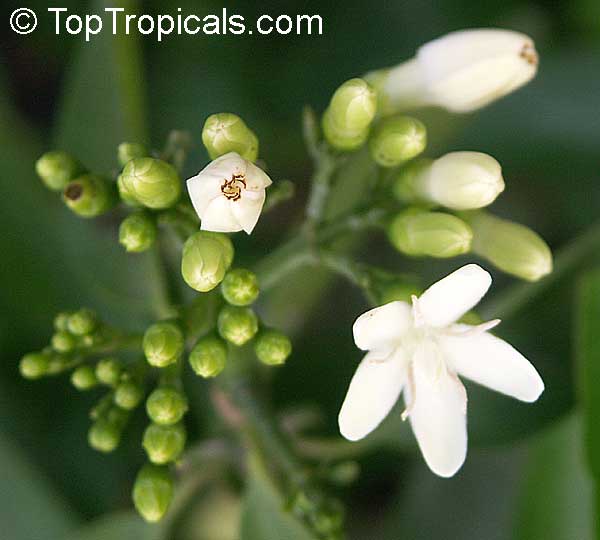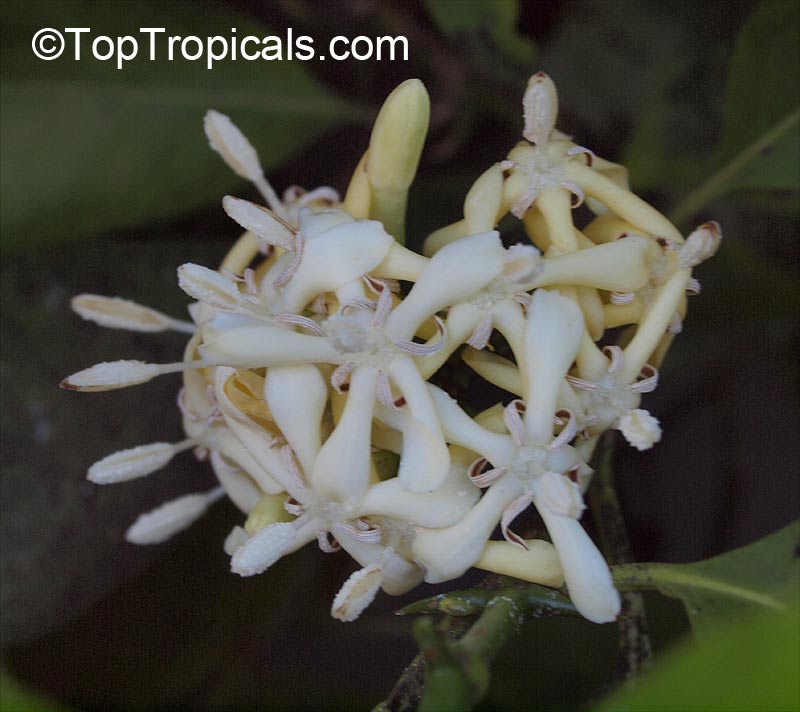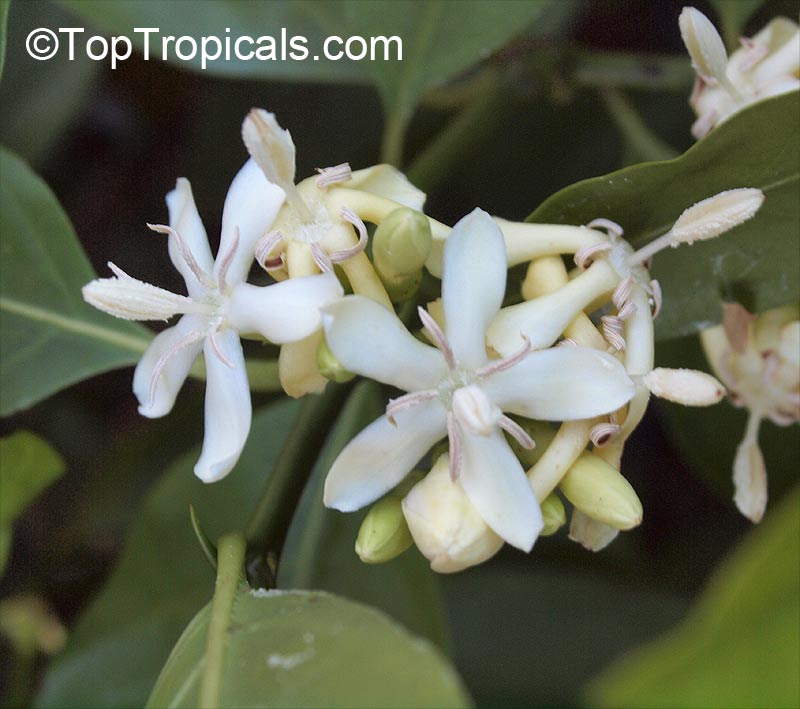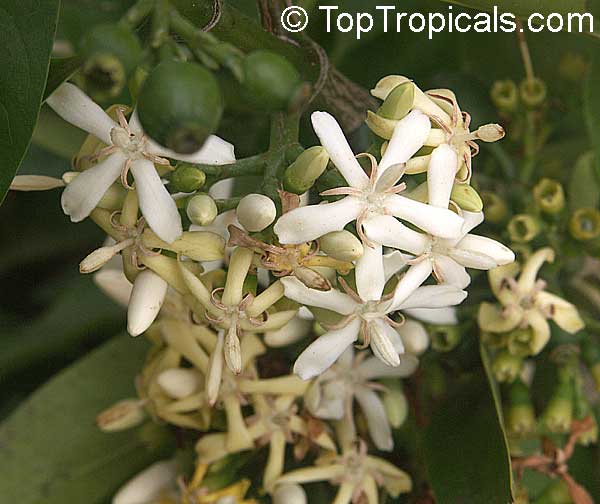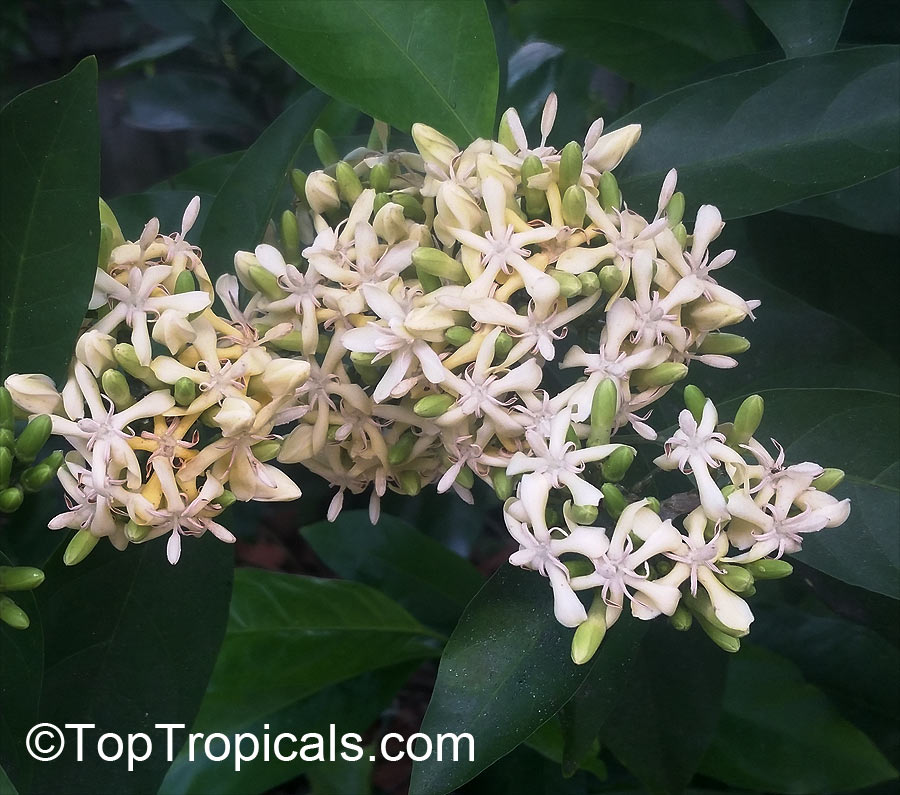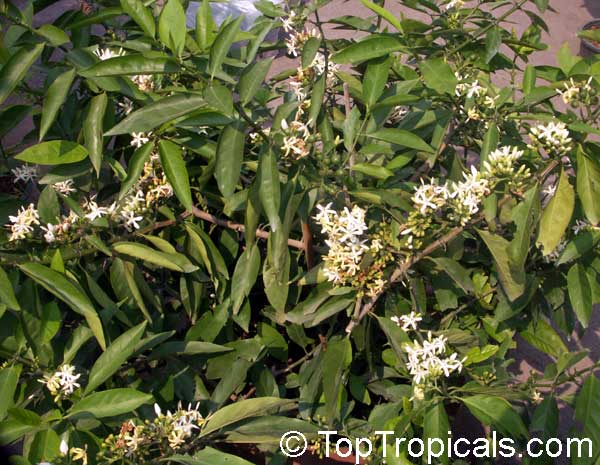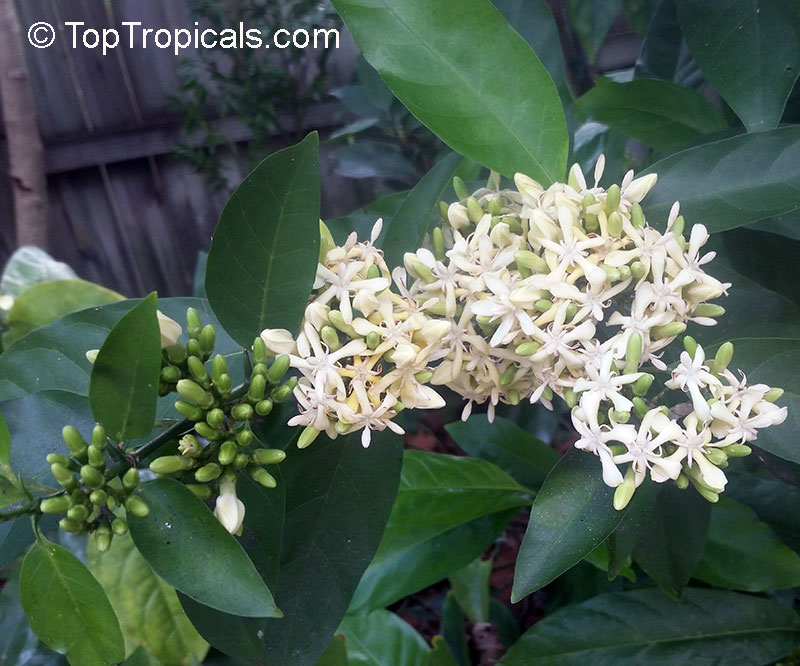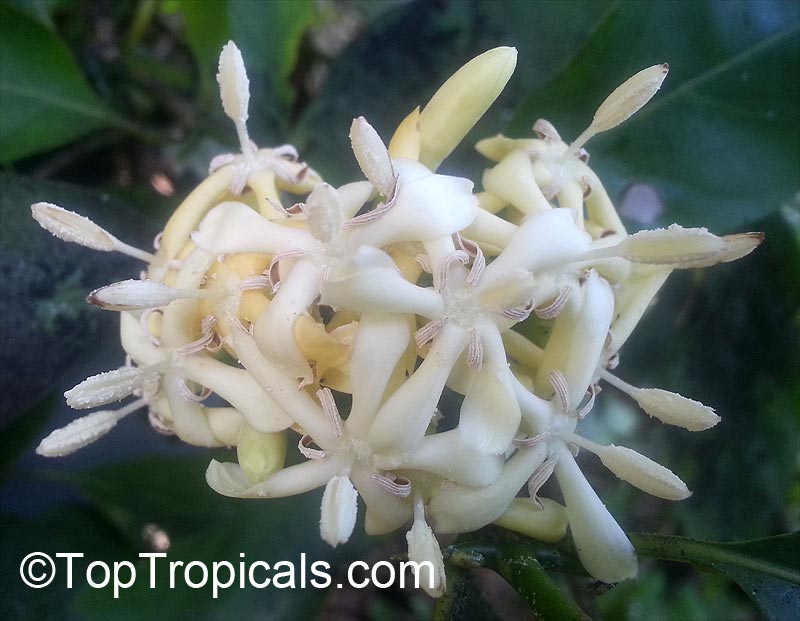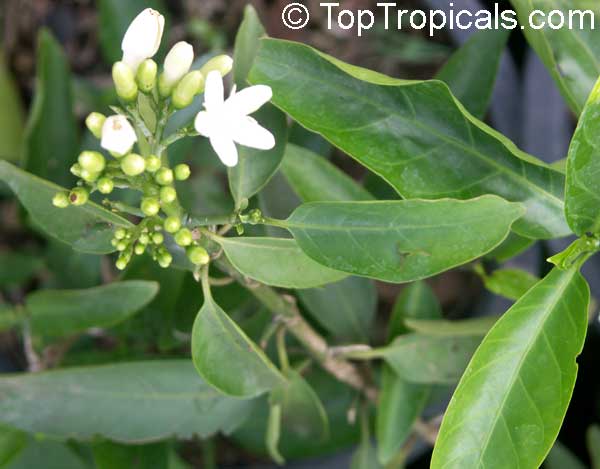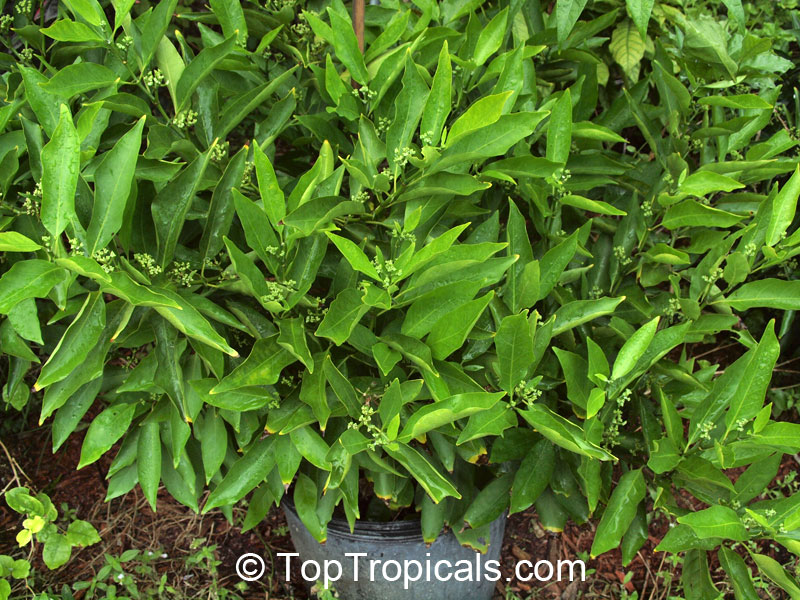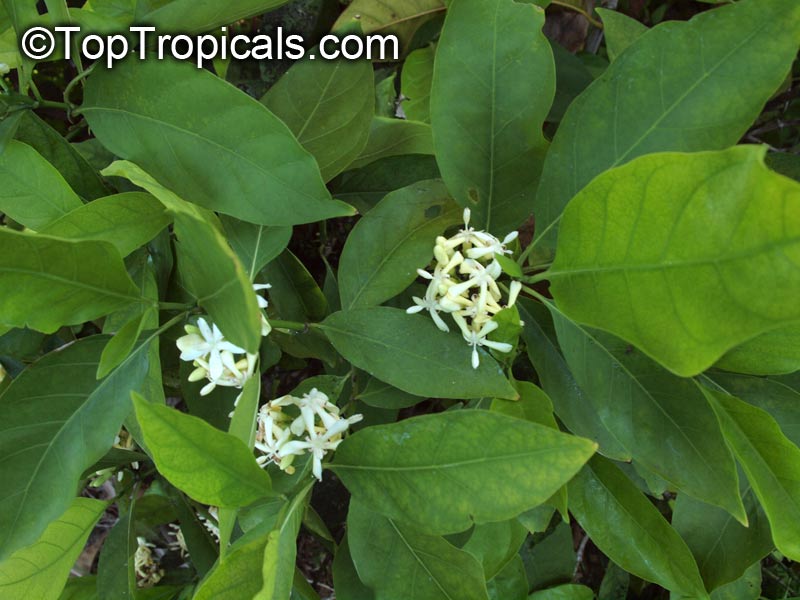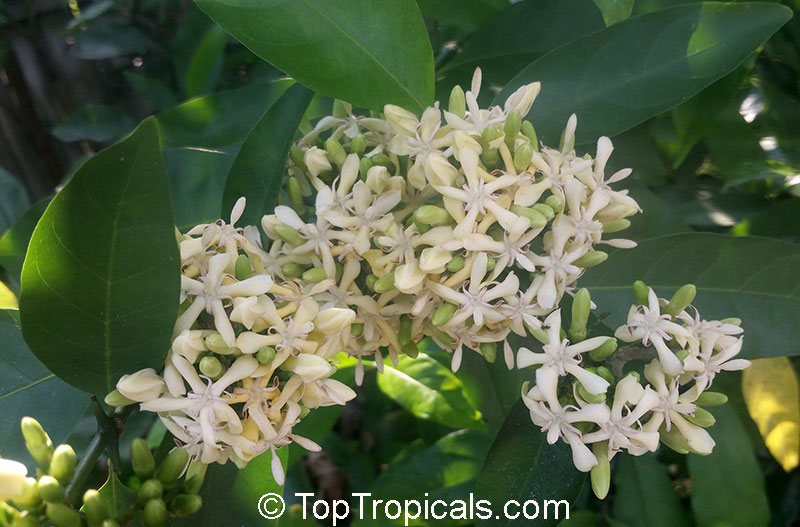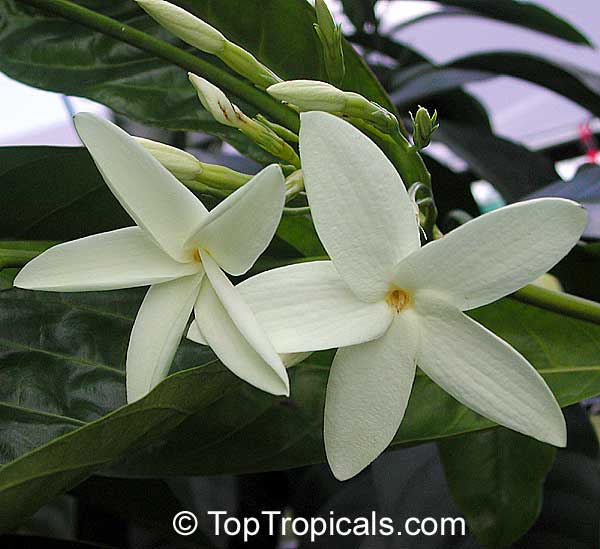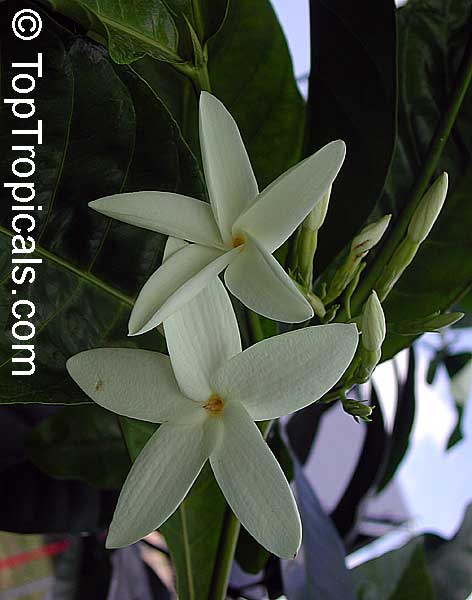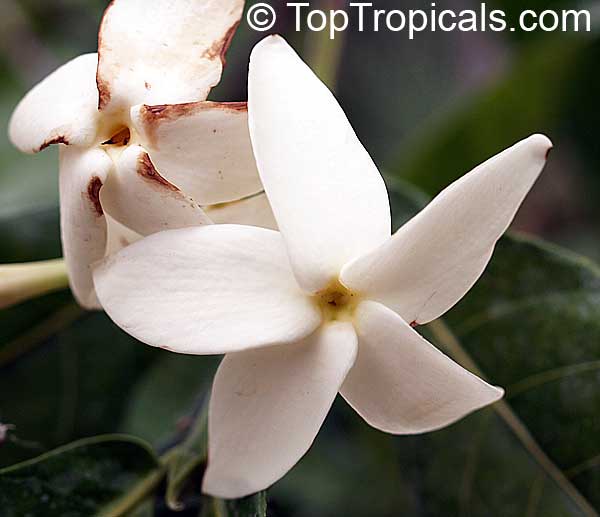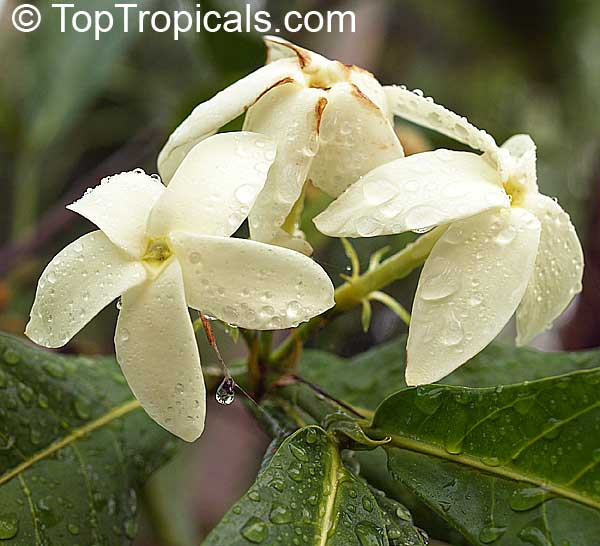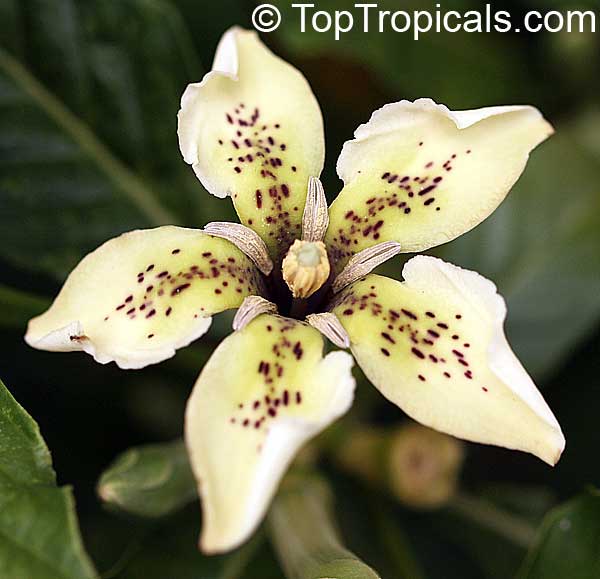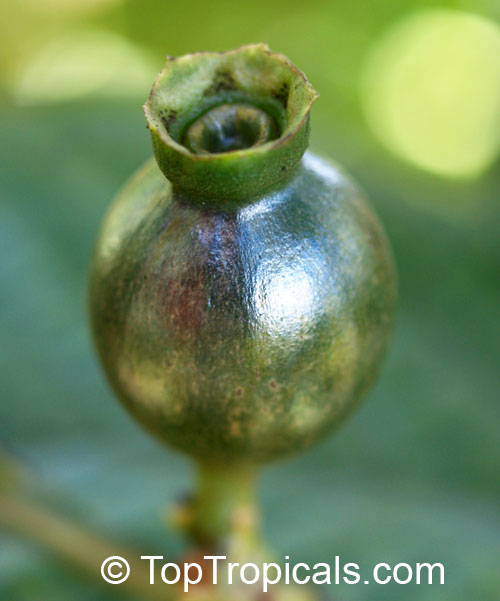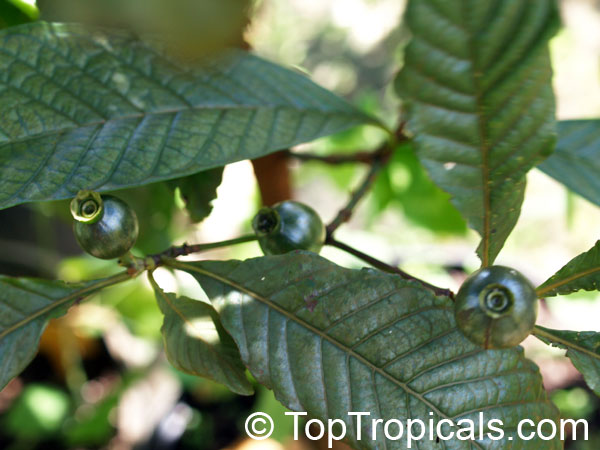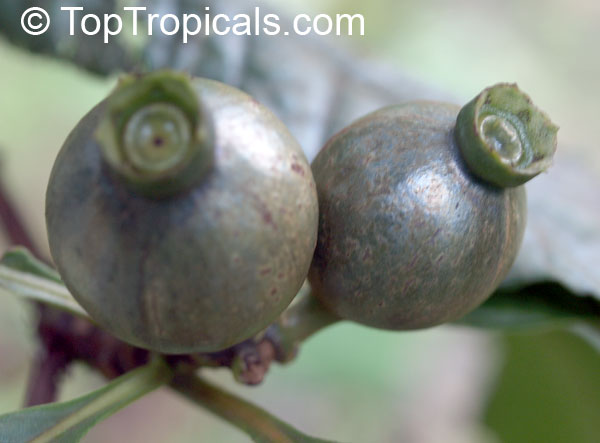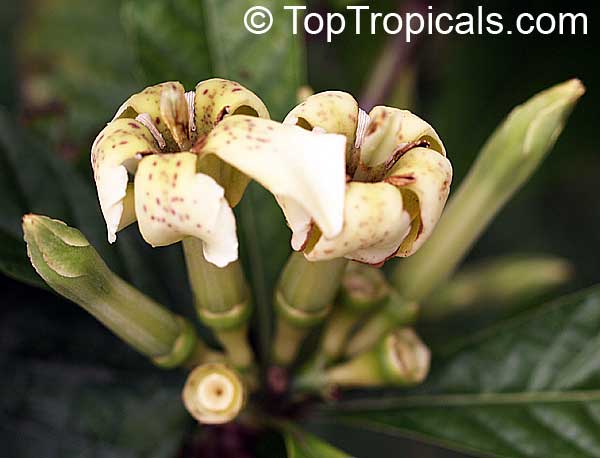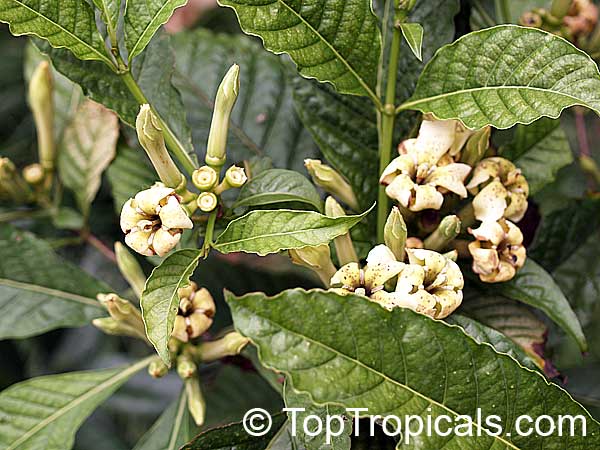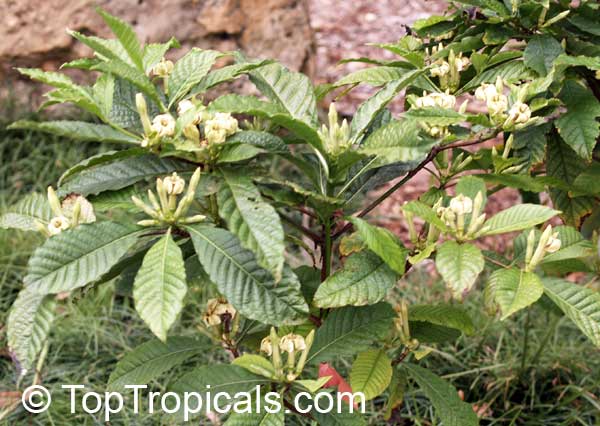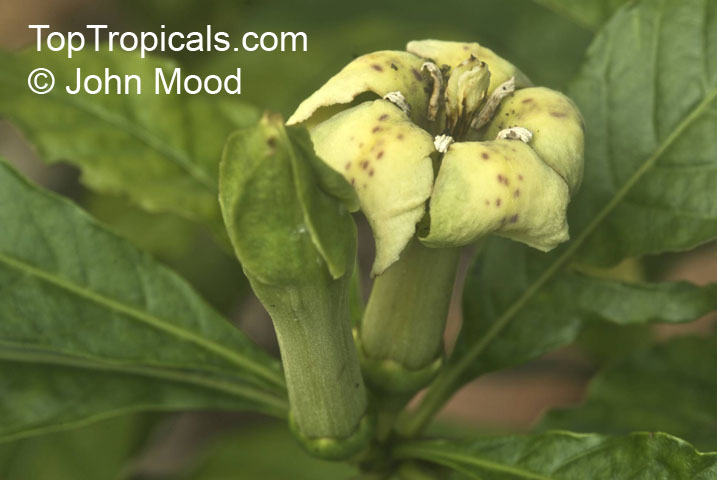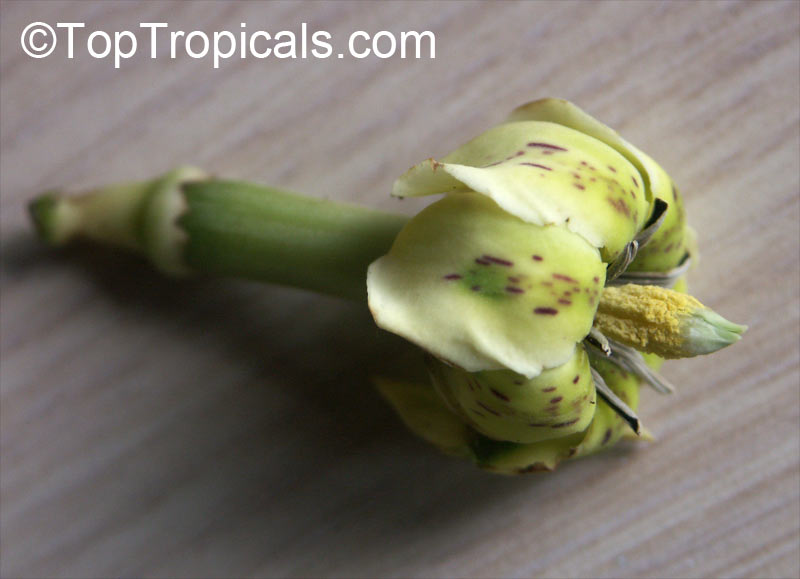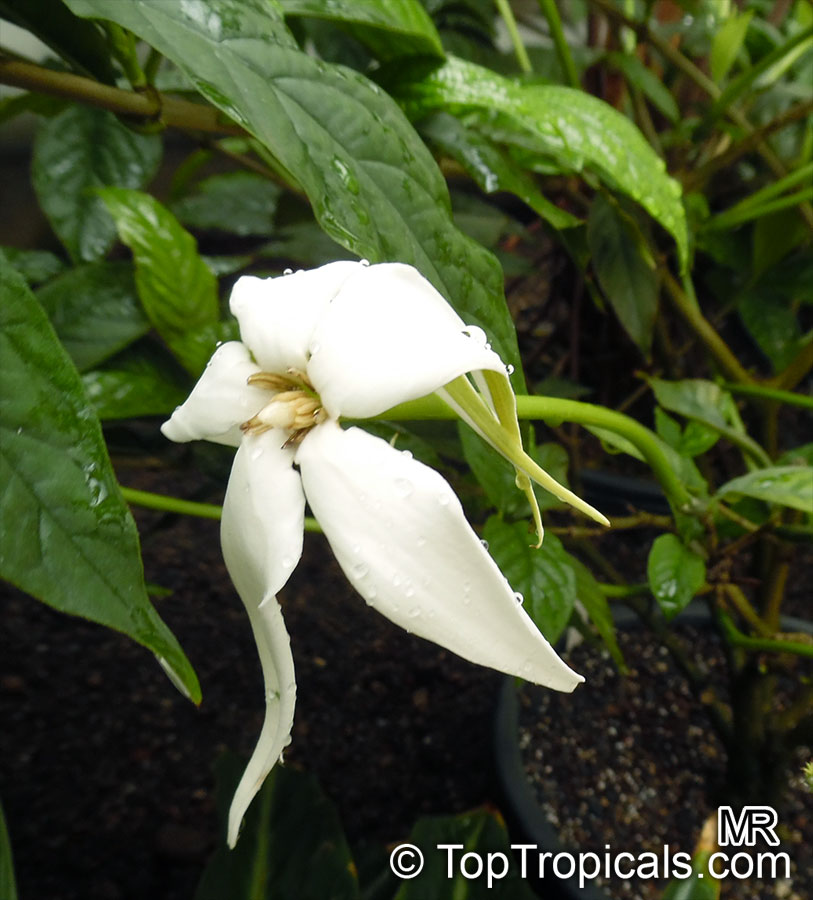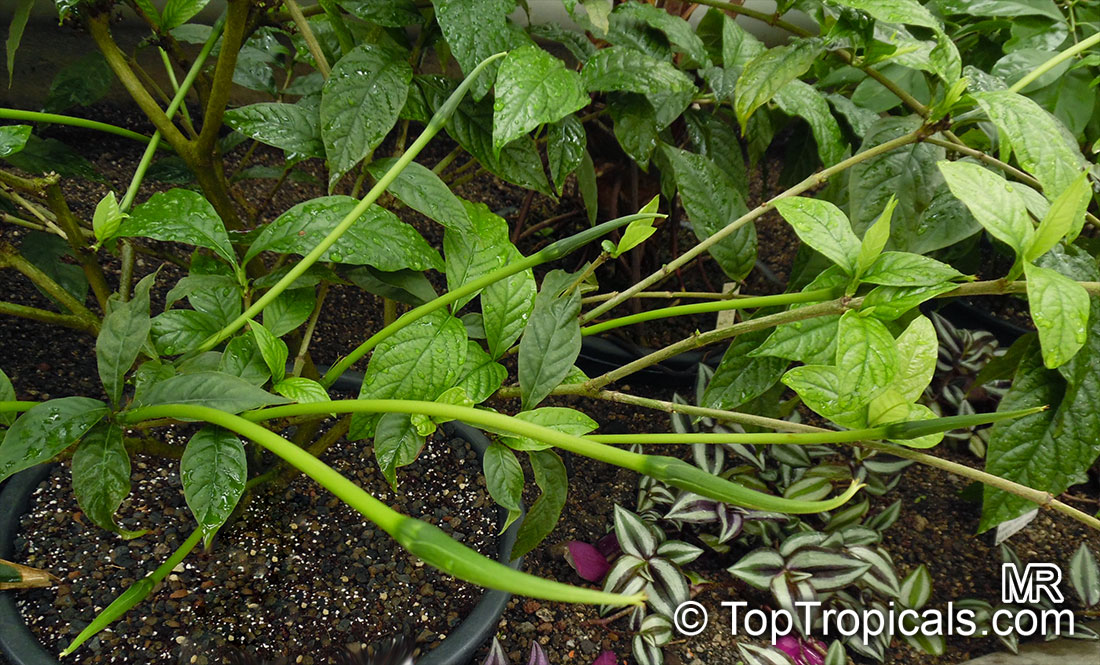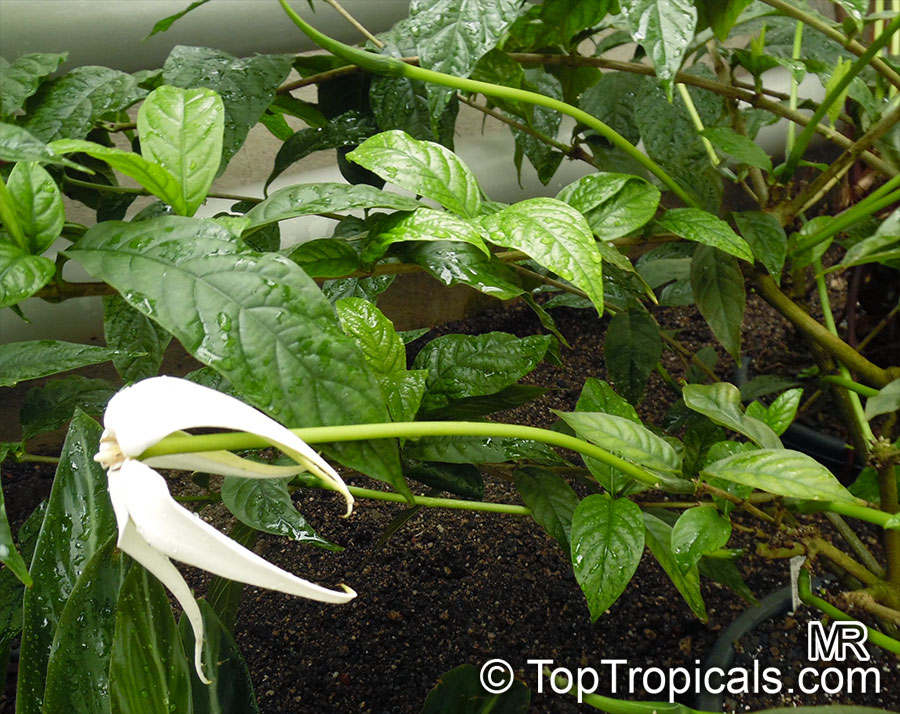Randia - Plant Encyclopedia Results
Top Tropicals Plant Encyclopedia
| Number of plants found: 10 |
Botanical names: Atractocarpus fitzalanii, Randia fitzalanii, Gardenia fitzalanii
Common names: Native Gardenia, Yellow Mangosteen
Family: Rubiaceae
Origin: Australia, Tropical Asia










Small tree, usually only to 10-20ft. tree with large, glossy green leaves. The white flowers have a gardenia-like perfume. Enjoys moist, warm environment of Rainforest. Dark shining foliage sets off these beautifully fragrant spring flowers. They are star-shaped and come in clusters. In late autumn, yellow skinned fruits develop, 2"-4" in diameter, filled with small seeds embedded in soft pulp, with a flavor resembling a mangosteen. Dense, shiny foliage, the leaves are large, dark green and glossy. Very tropical looking plant, rare in cultivation.
Botanical names: Catunaregam taylorii, Catunaregam spinosa, Randia vestita, Xeromphis obovata
Common name: Catunaregam
Family: Rubiaceae
Origin: South Africa








Shrub or small tree, armed with woody spines, usually in opposite pairs but sometimes alternate. Branches often spreading or trailing; young stems densely hairy and lenticellate. Leaves in clusters on short side shoots, just below the spines,usually young and just developing at time of flowering, densely velvety on both surfaces, especially when young, veining indented above. Flowers in 1-3-flowered clusters, white, fading to yellow, sweetly scented. Fruit broadly ellipsoid, ribbed, velvety.
Botanical names: Euclinia longiflora, Randia macrantha
Common names: Angel's Trumpets, Tree Gardenia
Family: Rubiaceae
Origin: Tropical Africa







Flowers of this tropical shrub are long tubes opening as a white fragrant trumpet, hence the common name. Gorgeous sight! Light green dense foliage resembling coffee leaves is also very ornamental. This is a very rare species. Can be grown in a pot as a houseplant, requires bright light for blooming.
Botanical name: Randia aculeata
Common name: White Indigoberry
Family: Rubiaceae
Origin: Central America









Randia aculeata loves the sun and should be planted in full sun for best growth and flowering. It will grow in partial shade as well, but flowering will be reduced. When young, Randia aculeata is often confused with a variety of other shrubs with reddish-colored spines. This is a large shrub, five to 10 feet tall and 5-6 feet wide. It is usually rounded and spreading in form, although it can be trained as a small tree.
Grown in USDA Zone 9-11, Randia aculeata is a very drought-tolerant and salt-tolerant plant. It will require regular waterings but can go extended periods without unless it is in extreme heat. It is a rare plant on the seaside but is tolerant of salt spray and windy conditions.
Randia aculeata has long been used for medicinal purposes in its native region of Central America. The fruits of the plant are often made into teas and used to ease indigestion and bring down fevers. It has also been used to treat respiratory problems, jaundice, and rheumatism. In addition to its medicinal uses, Randia aculeata is also a great plant for attracting butterflies, hummingbirds, and bees to the garden.
In potting for cool regions, Randia aculeata should be grown in part sun to light shade and be protected from severe cold. It should be in a well-draining potting soil and watered regularly, although it should not be kept constantly moist. It is a moderate feeder and should be fertilized lightly in spring and summer. In winter, water it sparingly and give no fertilizer. The Randia aculeata shrub can become root bound so repotting may be necessary every few years. If needed, the plant can be pruned lightly in late winter to shape.
Botanical names: Randia formosa, Mussaenda formosa, Randia mussaenda, Rosenbergiodendron formosum
Common names: Blackberry Jam Fruit, Jasmin de rosa
Family: Rubiaceae
Origin: Central and South America










It is a bushy evergreen tree or shrub, with star shaped, very fragrant, large tubular white flowers that attract nocturnal moths. Fruits look like small feijoas, and are 1 inch long and 1/2 inch wide. They really do taste like a blackberry jam! This Gardenia relative will bear fruit in a container.
Blackberry jam fruit, Jasmin de rosa - fragrant white flowers and edible fruit that tastes like blackberry jam! Rare exotic that will fruit in a container. Kids love the fruit!
This unique compact plant, perfect for container culture, combines features of a fragrant flower and tasty desert fruit. Originally from Central and South America, this rare tropical small evergreen tree bears fruit which tastes like fresh Blackberry jam. Many claim that it's even better than preserves. Closely related to the gardenia, its flowers are sweetly fragrant. This relatively hardy tropical has attractive foliage and can be grown in a container as well as in the ground. Produces as many as 25 to 30 fruits at a time. Since it blooms for a few months in the fall and winter, fruiting and flowering can be enjoyed when many other plants are dormant. Large tubular white flowers that attract nocturnal moths...
Long fruit variety "Lady Fingers" has long 2" fruit and larger flowers with long whiskers. It also blooms more profusely than regular round fruit variety.
This unique compact plant, perfect for container culture, combines features of a fragrant flower and tasty desert fruit. Originally from Central and South America, this rare tropical small evergreen tree bears fruit which tastes like fresh Blackberry jam. Many claim that it is even better than preserves. Closely related to the gardenia, its flowers are sweetly fragrant. This relatively hardy tropical has attractive foliage and can be grown in a container as well as in the ground. Produces as many as 25 to 30 fruits at a time. Since it blooms for a few months in the fall and winter, fruiting and flowering can be enjoyed when many other plants are dormant. Large tubular white flowers that attract nocturnal moths.
variety.
See Article about Randia formosa.
Recommended Fertilizer: SUNSHINE C-Cibus - Crop Nutrition Booster
SUNSHINE-Honey - sugar booster
Botanical names: Randia maculata, Randia longiflora, Rothmannia longiflora
Common name: Terompet Gading
Family: Rubiaceae
Origin: South East Asia






Randia maculata, also known as Terompet Gading, is a shrub native to South East Asia and makes an interesting ornamental garden plants. It is a robust shrub that grows to a height of five to ten feet tall, with soft, lanceolate foliage and small white to off-white flowers that have a lovely fragrance. It is an easy to grow plant and is suitable for growing in USDA Zones 9 to 11.
In full sun, the Randia maculata will flower better, and it will require regular watering in order to perform well. Also, this shrub adds interest to the landscape and attracts butterflies and hummingbirds with its fragrant flowers. To make this shrub look even better, regular pruning is necessary, removing any dead or damaged leaves or stems.
For cold regions or areas where temperatures drop below freezing, the Randia maculata should be planted in a tall pot or container. When grown in a pot, the plant should be moved indoors during winter months, so it can be protected from the extreme temperatures. It should also be placed in a location inside the house where it will receive enough sunlight. During summer months, the shrub should be kept outdoors in full sun and watered regularly.
To keep the Randia maculata in top shape and make sure it continues to bloom, make sure the soil remains hydrated. If the soil is dry, water the shrub generously but infrequently. If grown in a pot, the Randia maculata should be repotted every two to three years, using a rich, well-draining potting soil. Also, this shrub benefits from regular fertilizing during the growing season, using a liquid fertilizer every two weeks.
The Randia maculata is an attractive and fragrant shrub that adds a unique touch to any landscape. Providing it with proper care and growing it in the right conditions will ensure vibrant blooms, and its beautiful flowers attract butterflies and hummingbirds.
Recommended Fertilizer: SUNSHINE Pikake - Fragrant Flower Booster
This item can not be shipped. Pick up only. We can provide local delivery around Ft. Myers or Sebring, Florida. Contact us for an estimate. Non-pickup orders are subject to restocking fees.
Botanical names: Randia siamensis, Oxyceros horridus
Common name: Fragrant randia
Family: Rubiaceae
Origin: Thailand










Medium size shrub with highly perfumed 1" wide white flowers that attract bees and butterflies. Flowers come in clusters. The plant has woody thorns on the stem that makes it look unusual for such a fine flowering shrub. Foliage is dark green, sometimes blueish. Can be grown in a pot and as a bonsai. Blooms almost year-round, easy in cultivation. The plant has medicinal properties - analgesic activities, blood tonic, blood purifier.
Botanical name: Randia sp.
Common name: Gardenia Star of Africa
Family: Rubiaceae
Origin: Africa








It is a showy and attractive landscape plant and will attract butterflies, hummingbirds and other pollinators.
For optimal growth, water Randia sp. regularly and feed with a balanced fertilizer in spring. Prune the plant after flowering, to keep a neat shape. In colder regions, where it is not winter hardy, it can be grown in a container and brought inside for the cold months. When grown in a pot, choose a potting mix best suited for acid loving plants, such as azaleas, camellias and gardenias. Give it plenty of sun and shade during the hottest hours of the day. Water regularly, but avoid overwatering. Apply a slow release fertilizer early in the season and provide frequent water-soluble fertilizers during the growing season. It can be grown in USDA Zone 9-11. The plant can tolerate temperatures down to the lower-30s F for a short time, but usually shows damage at those temperatures.
Botanical name: Randia sp.
Common name: Randia
Cultivar: Joseph Fondeur
Family: Rubiaceae
Origin: Peru






Randia sp. Joseph Fondeur or Randia as it is commonly known as is a large shrub or a small tree native to Peru Lake Sandoval. It has an upright growth pattern, reaching a height of 5-10 feet in the shrub form and 10-20 feet when it is trained into a tree. It is best grown in semi-shaded areas and prefers regular watering.
In the summer months, Randia is known for its gorgeous white and off-white flowers that bloom during the warmer season. Interestingly, the trumpet-like blooms are unusually colored in chartreuse with splashes of burgundy. The light green corrugated leaves are also quite eye catching.
USDA Zone 9-11 is the ideal environment for growing this unusual tree. Colder regions may still be able to accommodate Randia, but extra care must be taken. When growing Randia in a pot in colder regions, the container should be raised off the ground to allow drainage.
Botanical names: Rosenbergiodendron longiflorum, Randia ruiziana, Randia formosa var. longiflora, Gardenia longiflora
Common name: Angel of the Night
Family: Rubiaceae
Origin: South America







Rosenbergiodendron longiflorum, commonly known as the Angel of the Night, is a large shrub native to South America. It stands between 5 and 10 feet tall, and produces a fragrant, off-white flower. The shrub has glossy,dark green leaves and a spreading, dense canopy that is semi-shady. It is ideally grown in USDA zones 9-11, and requires regular watering for the best results.
This shrub is also available as a smaller version, standing between 2 and 5 feet high. It has the same glossy foliage and produces the same fragrant, off-white flowers. The shrub is also hardy and relatively easy to grow in cooler USDA zones, provided it is grown in a pot and is well- insulated.
The edible fruit of the Angel of the Night is cylindrical in shape and light yellow in color with dark yellow stripes when ripe. It can produce up to 20 fruits per plant and is packed with nutritional benefits. The fruit is very rich in antioxidants and vitamin C which aids in promoting a healthy heart and reduces the risk of age-related chronic diseases. It is also packed with essential minerals and fiber. The fruit has a sweet, pleasant flavor and can be used for cooking and for juicing.
Overall, Rosenbergiodendron longiflorum is a beautiful plant with a beautiful flower and an edible fruit. Its delicate foliage and fragrant flower make it an attractive ornamental shrub, while its nutritional fruit provides a healthy snack. Whether grown in pots in the cold regions, or on its own in the warmer districts, the Angel of the Night is a must-have for any garden.
Use link to repeat this search:
https://toptropicals.com/cgi-bin/garden_catalog/cat.cgi?find=Randia&search_op=and&keyword_op=and&language=e&number=10
&no_change_lang=1&user=tt&sale=1&first=0
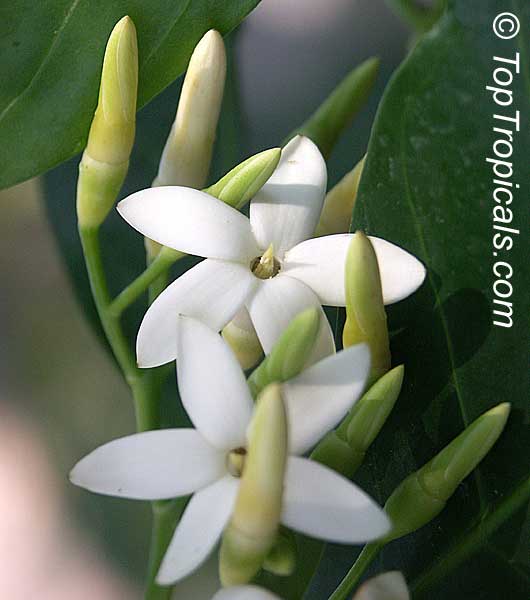
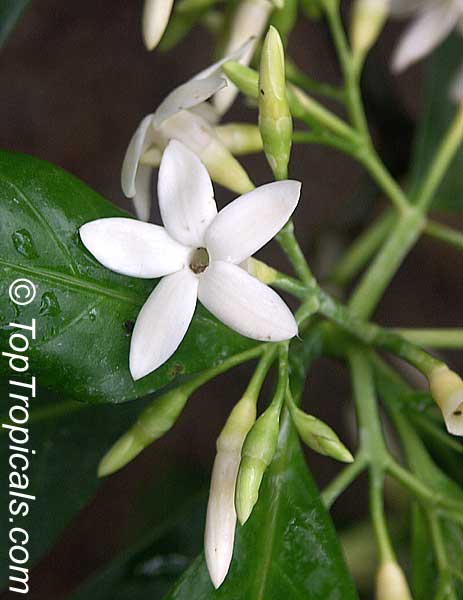
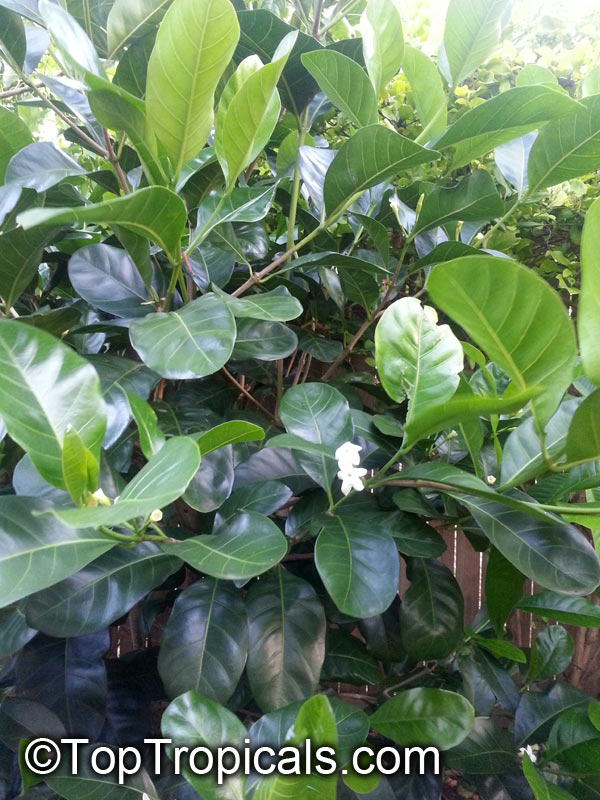
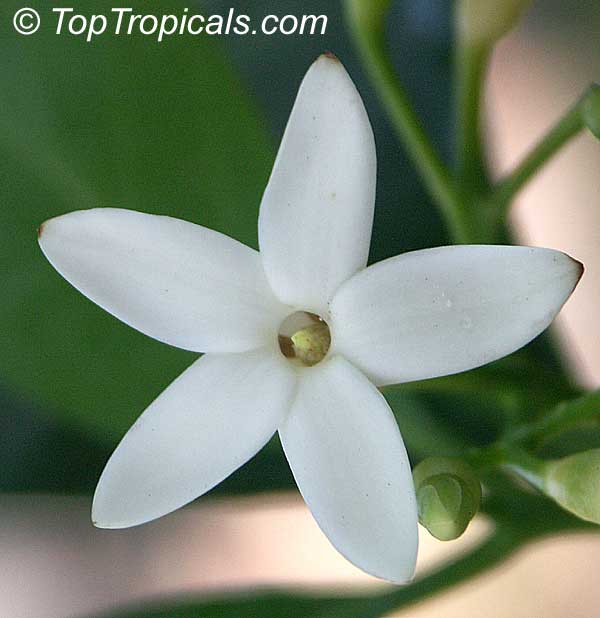
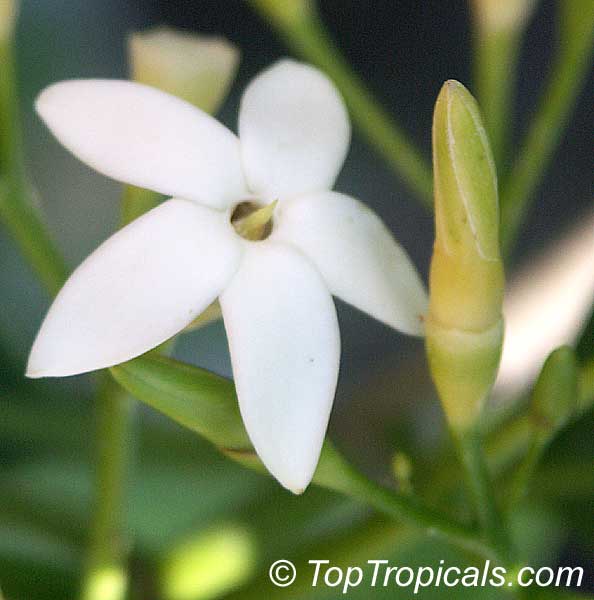
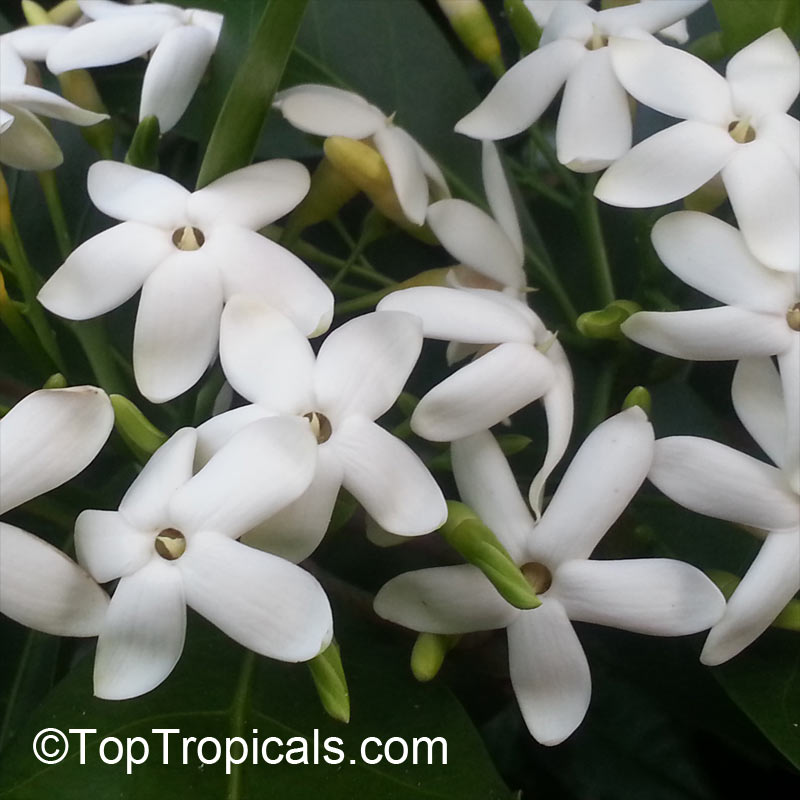
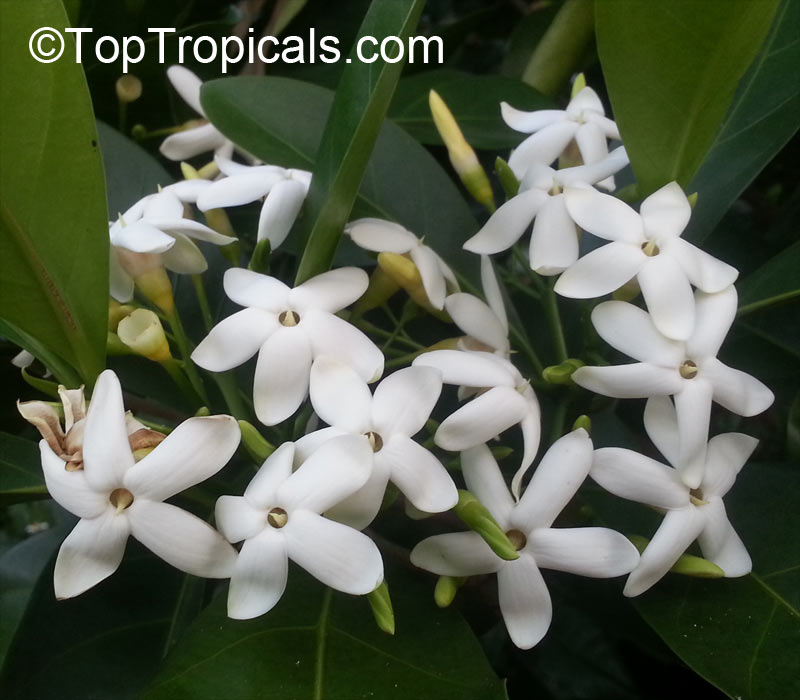
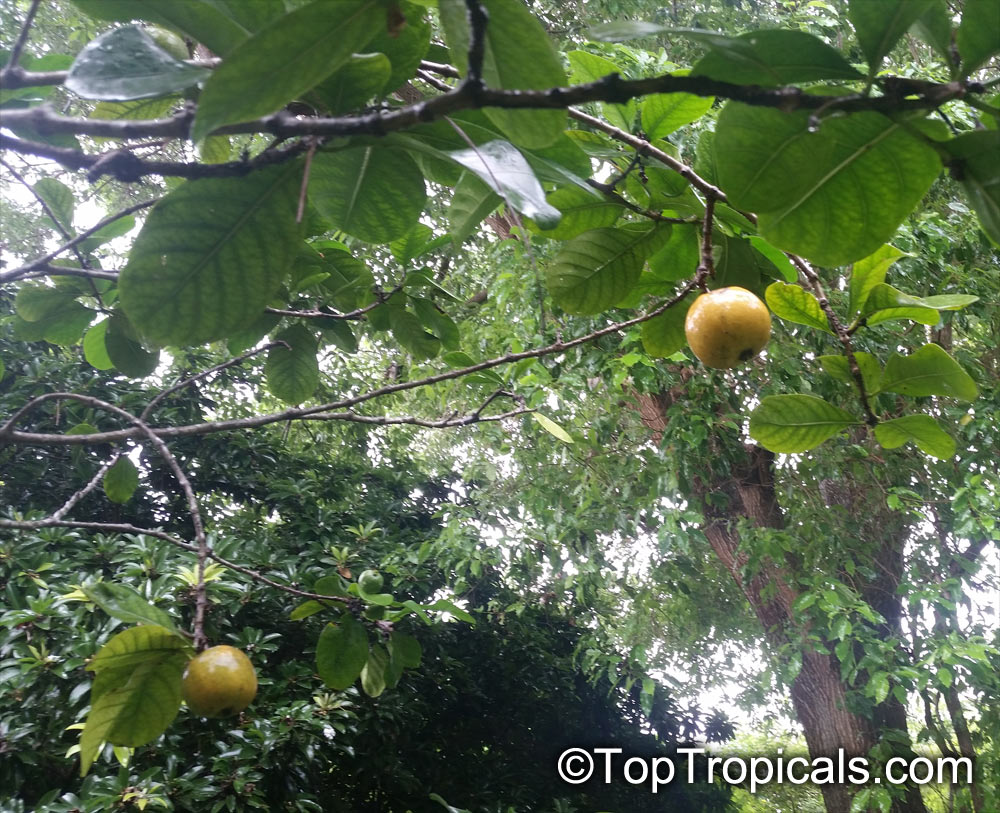
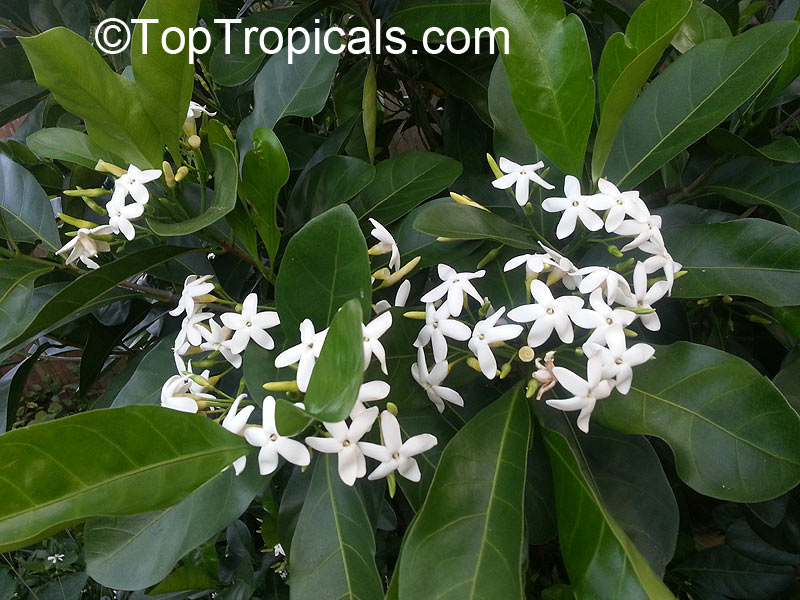
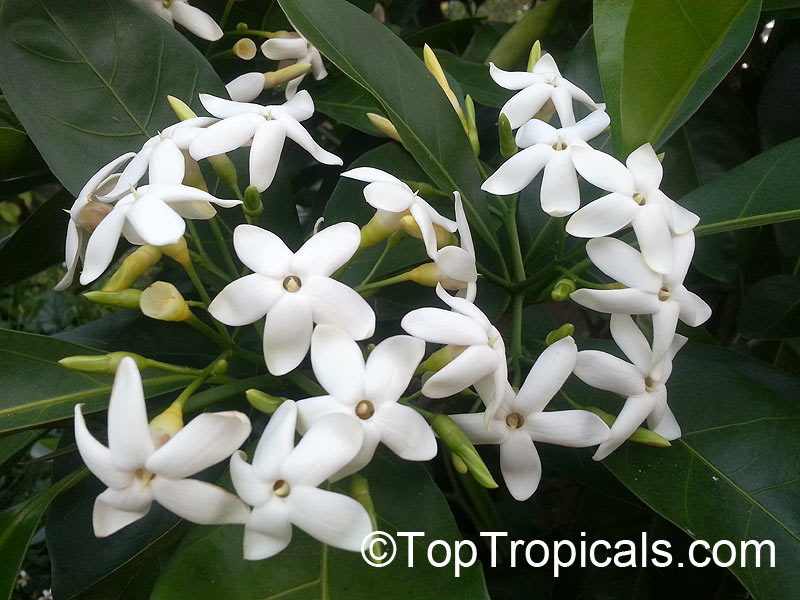
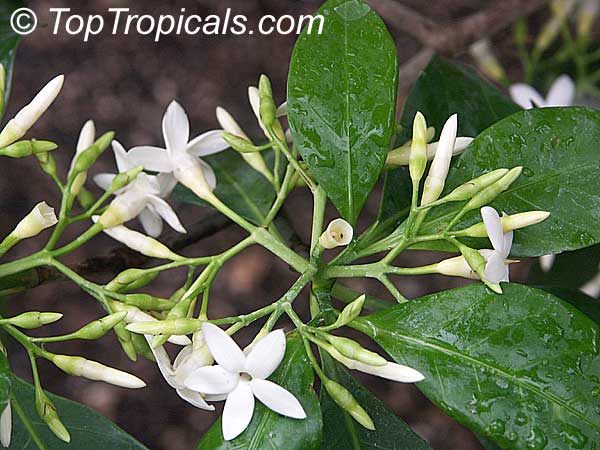
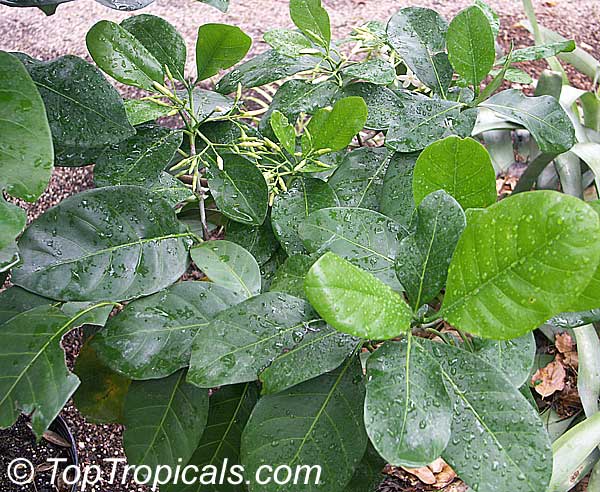
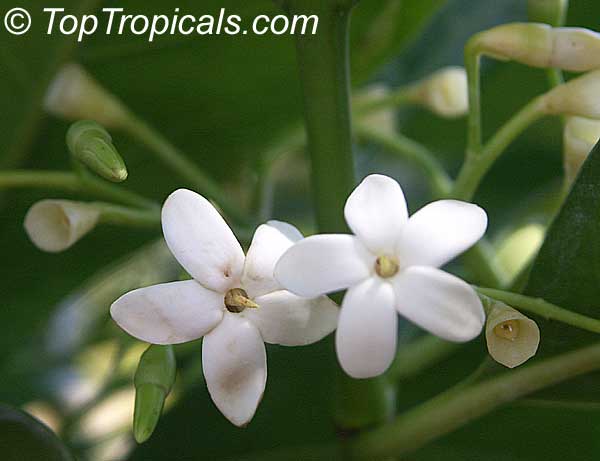
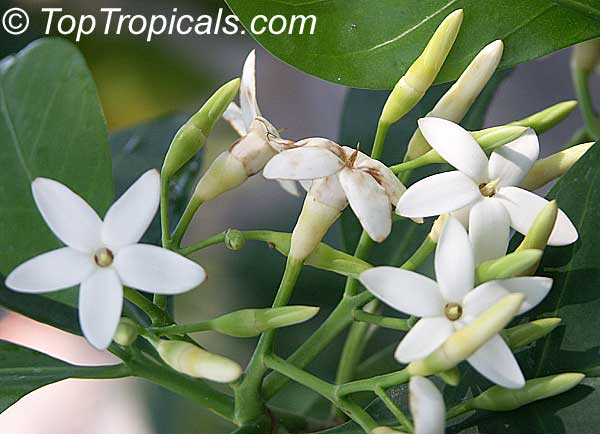
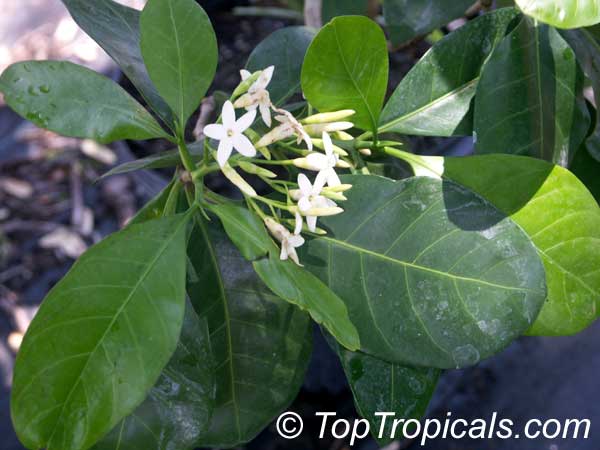
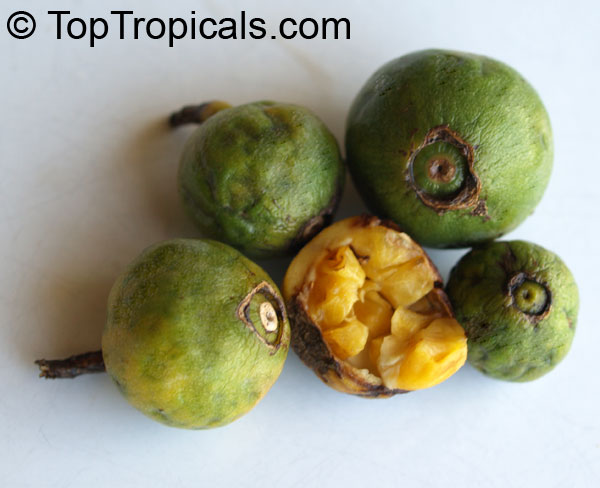

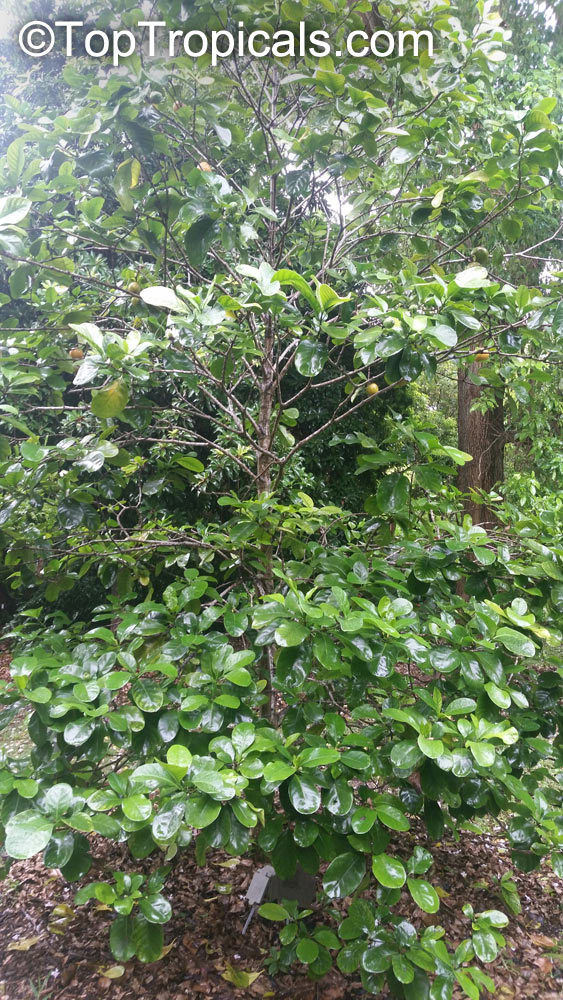
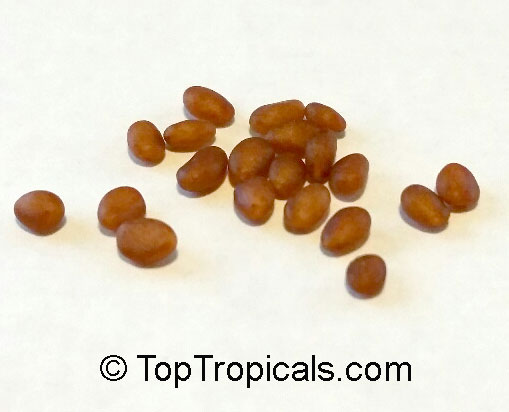
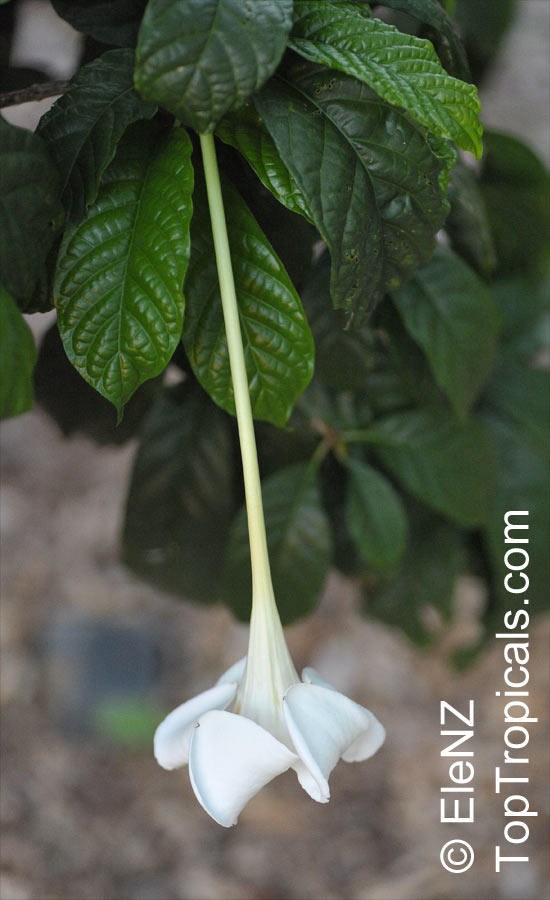
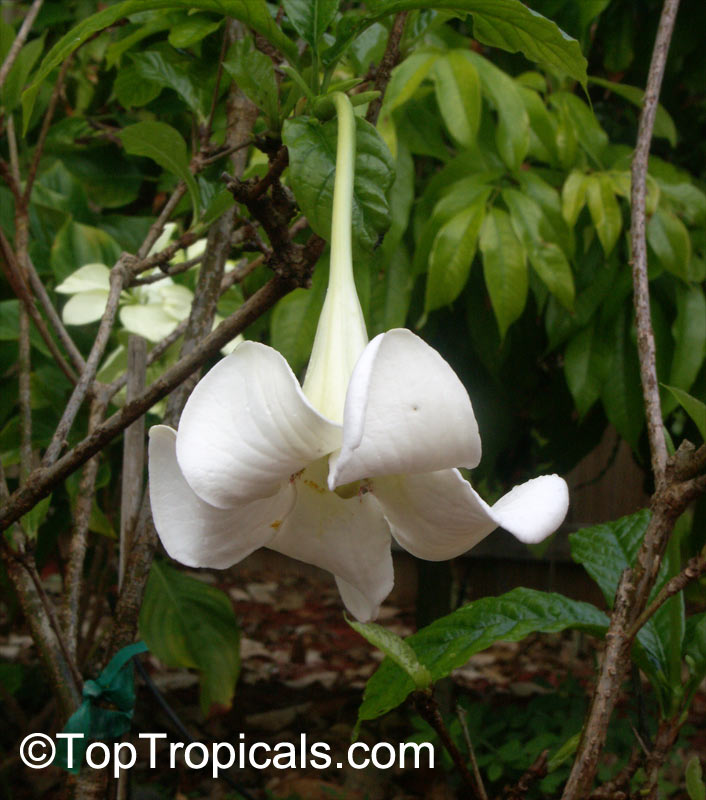
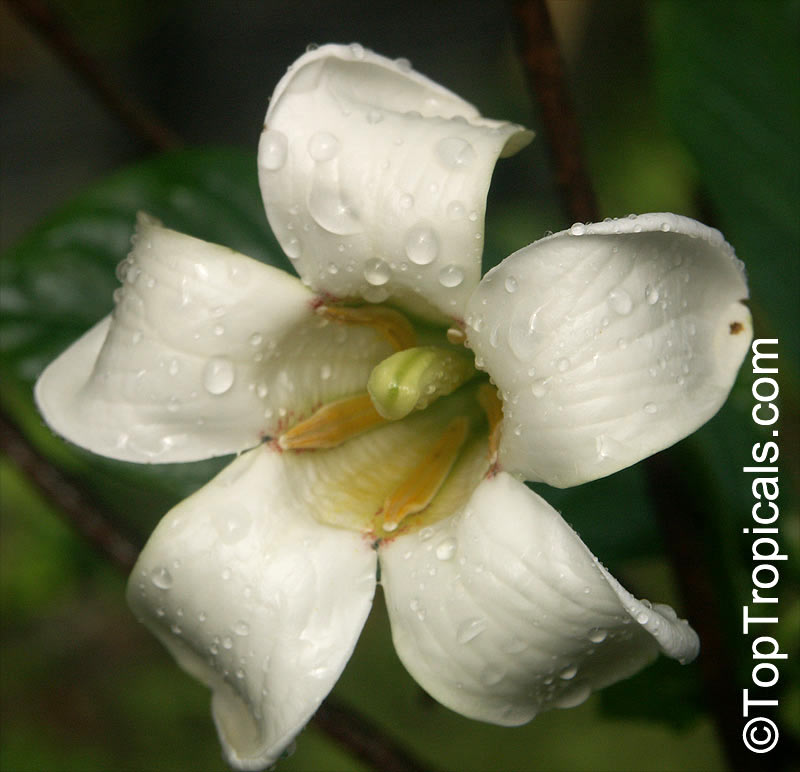
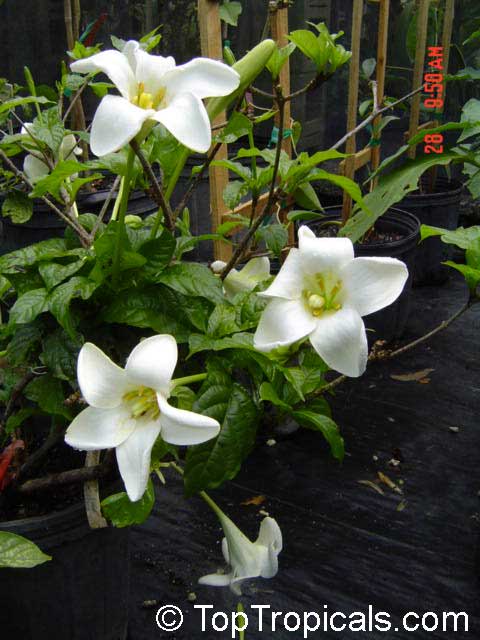
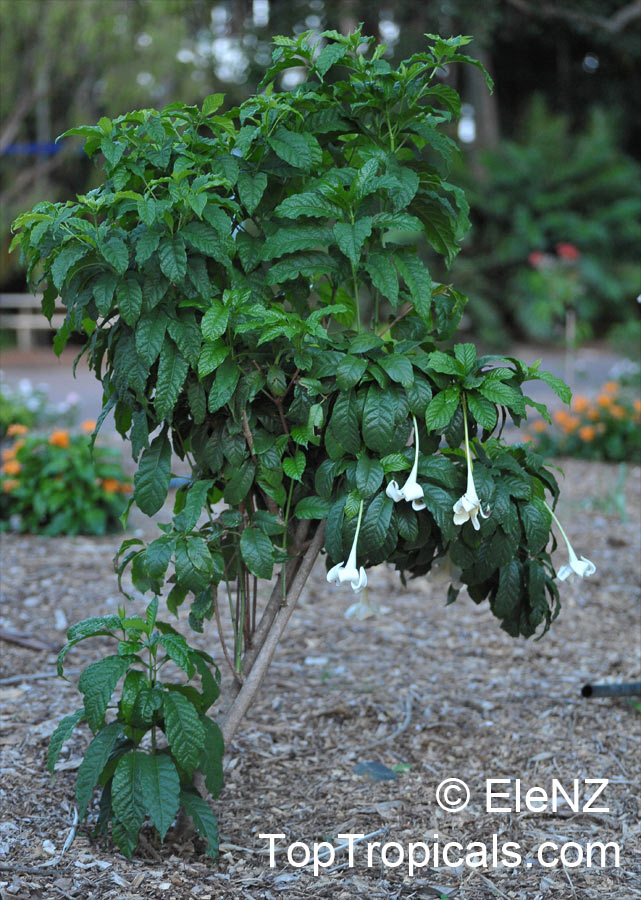

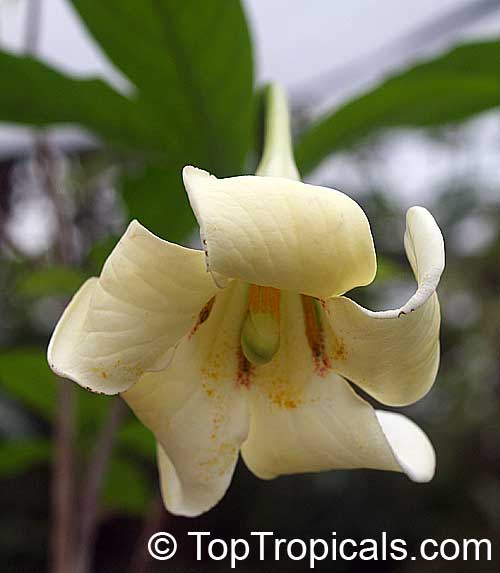
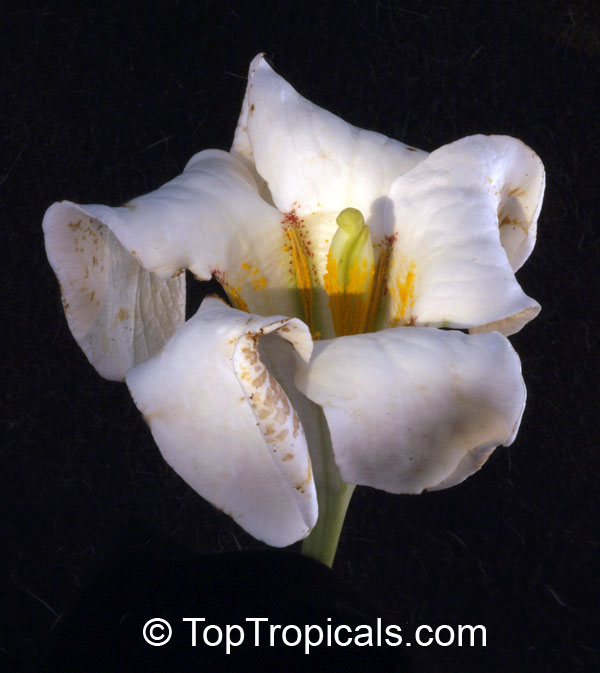
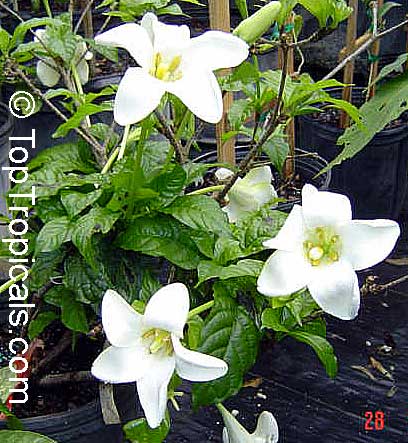
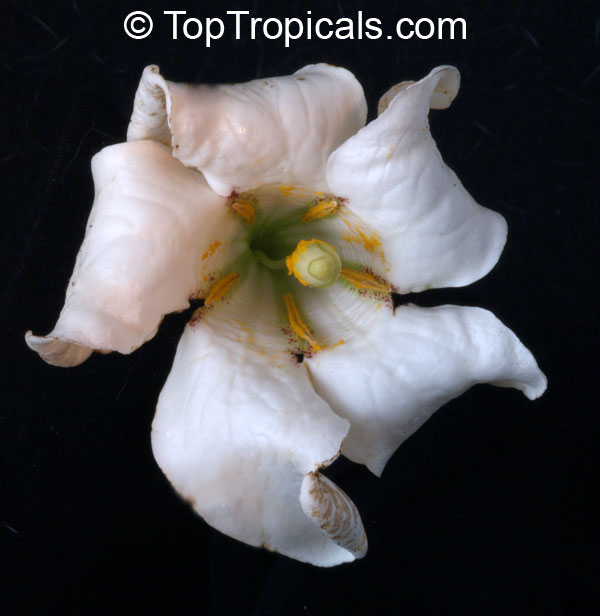
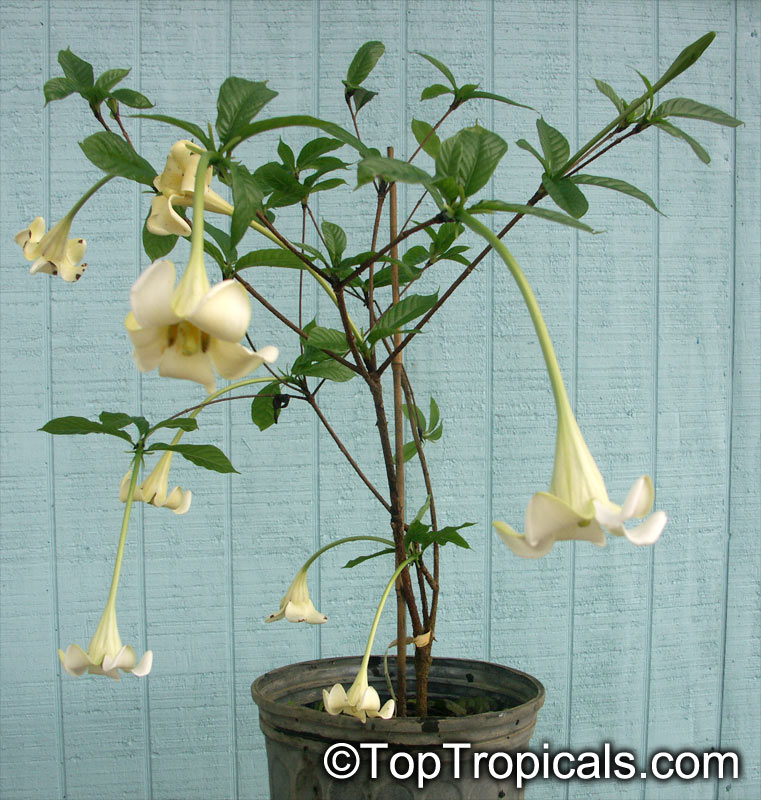
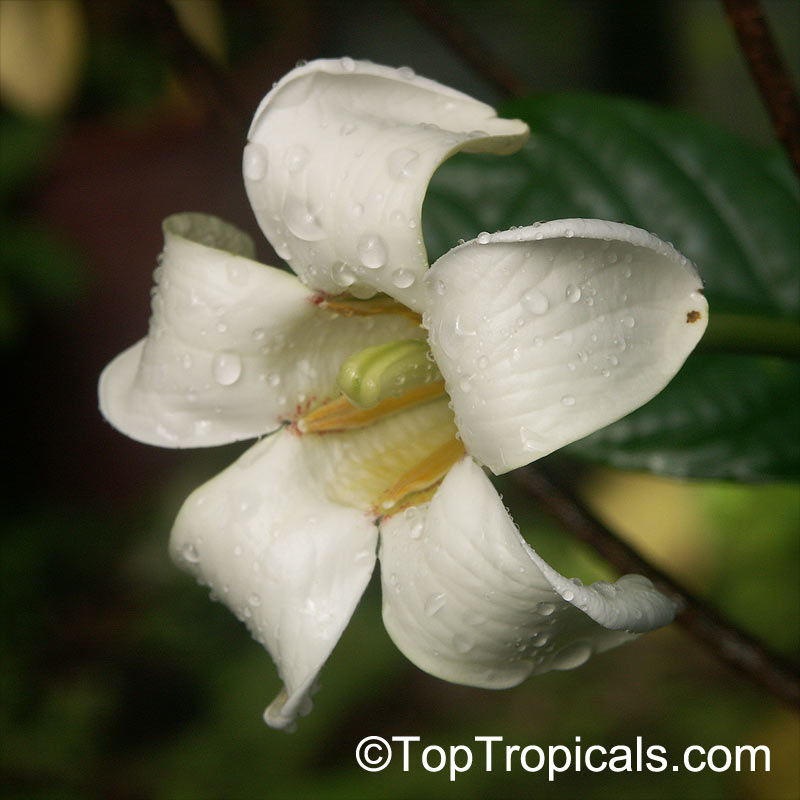
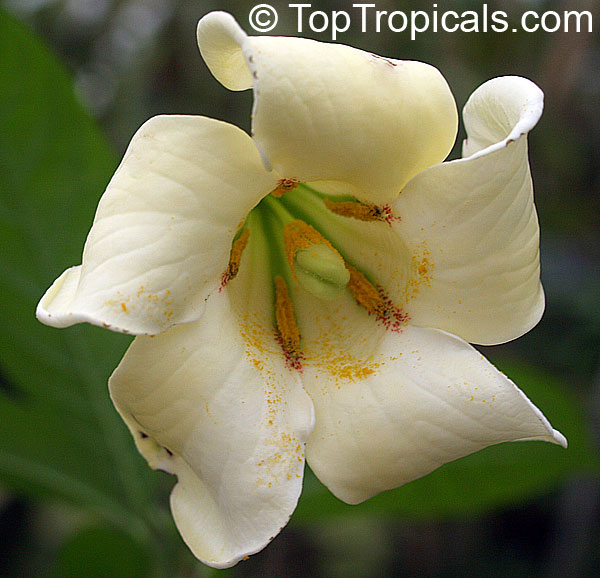
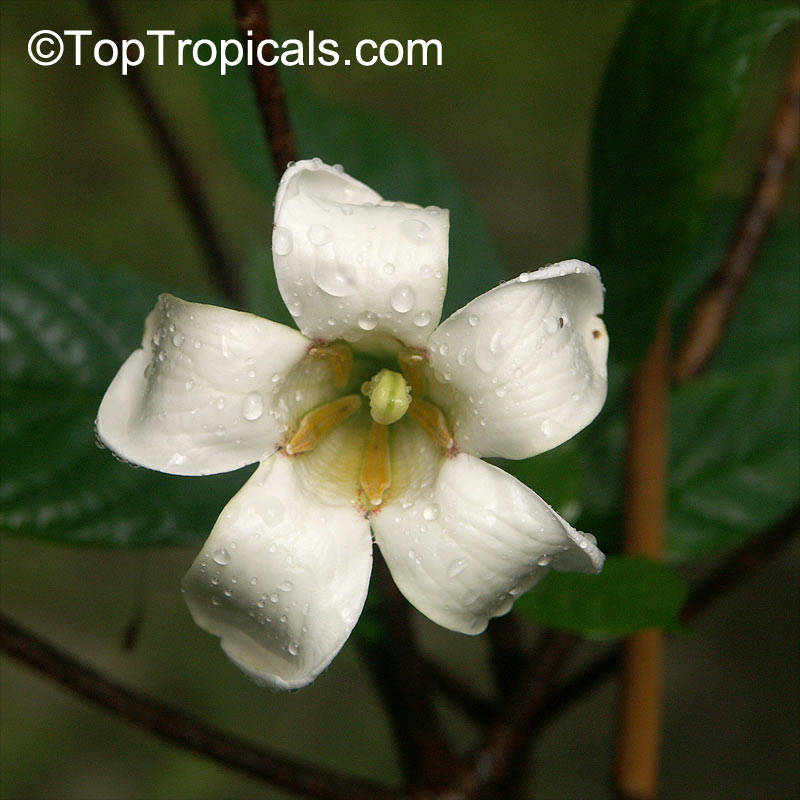
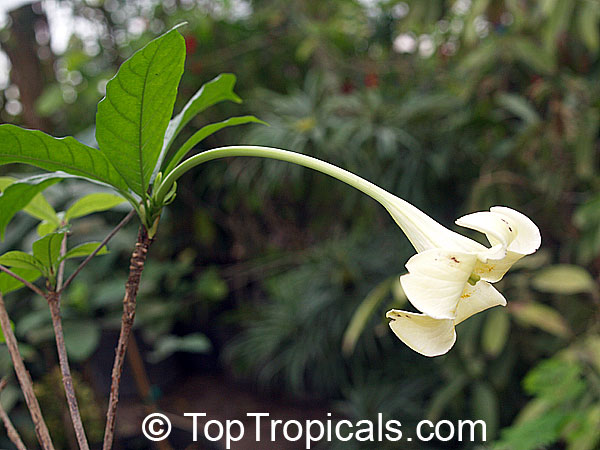
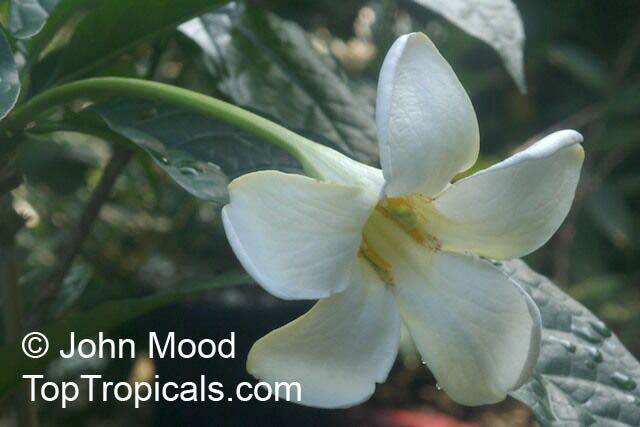
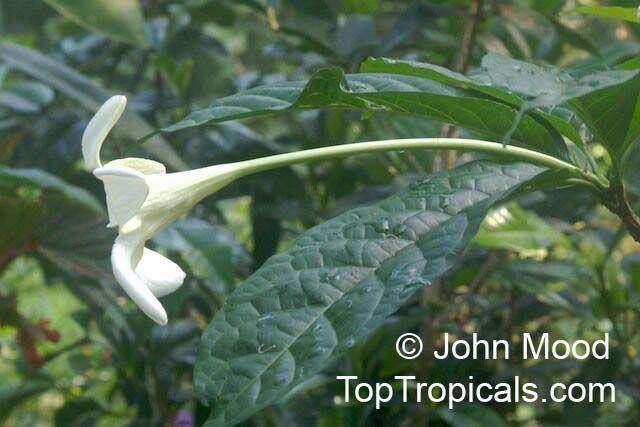
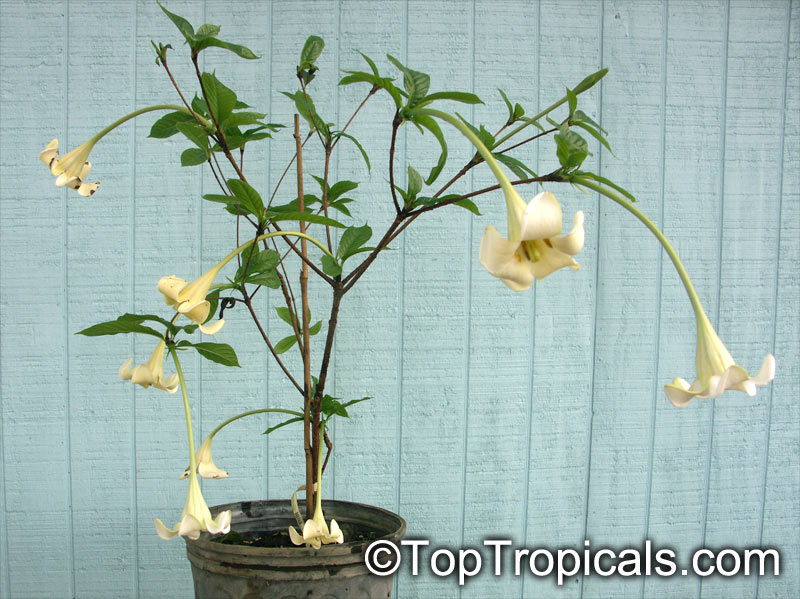
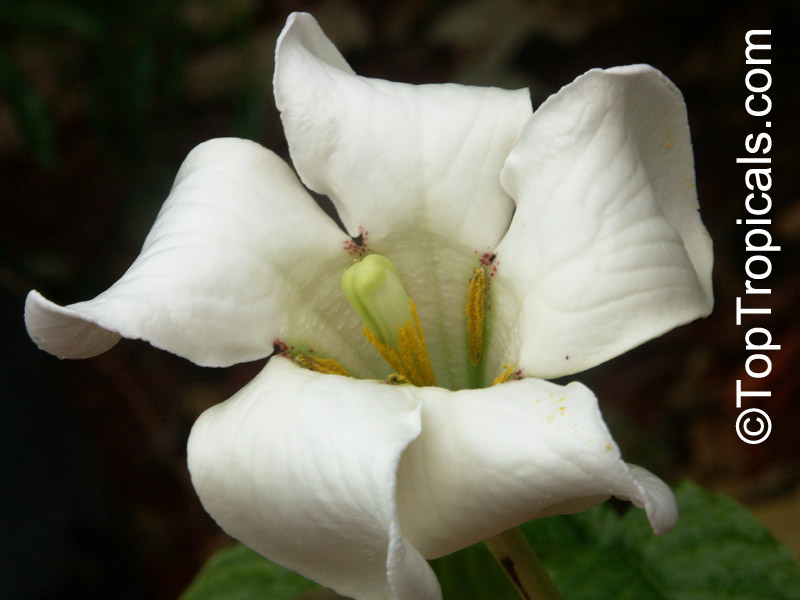
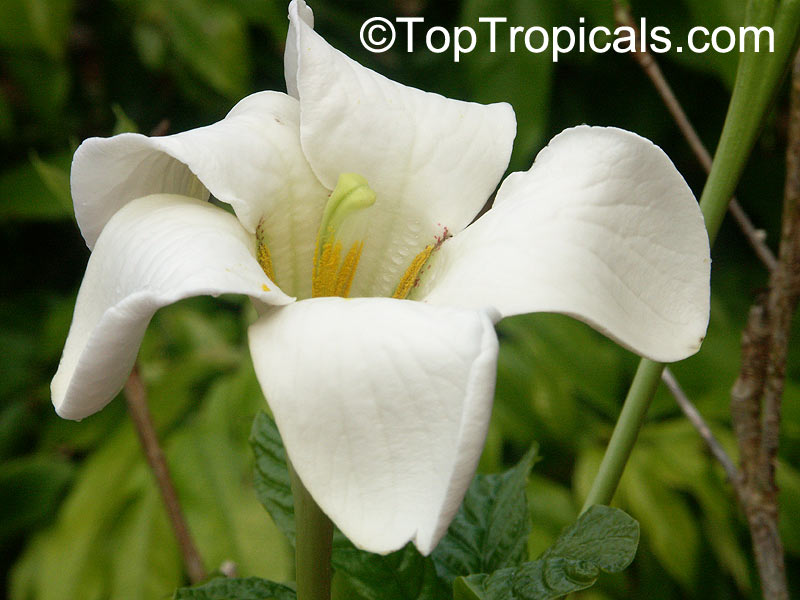
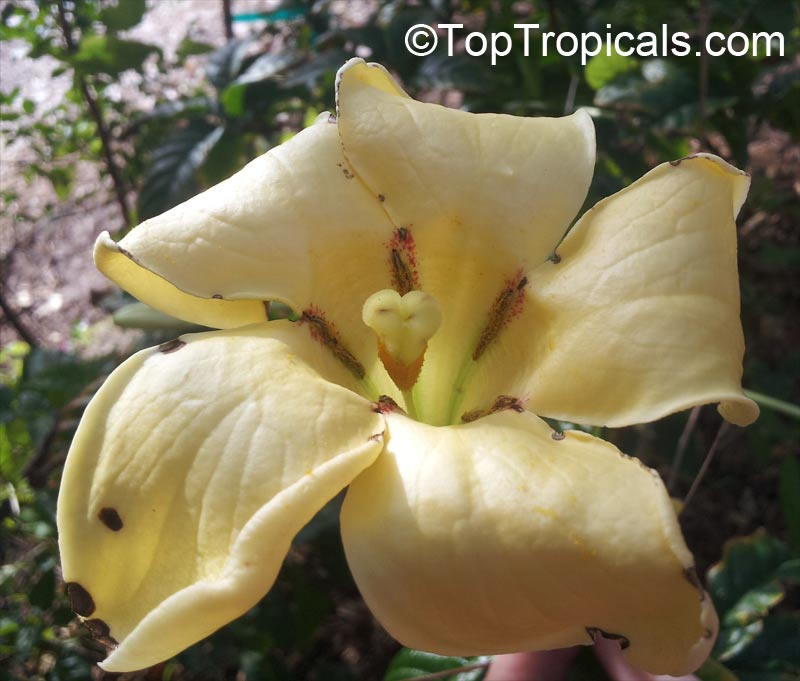
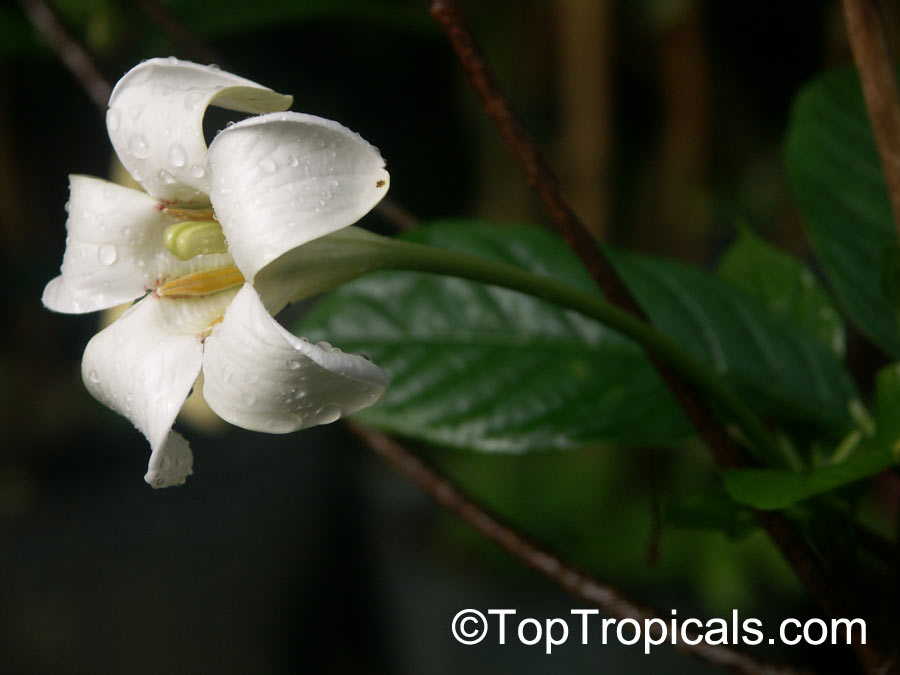
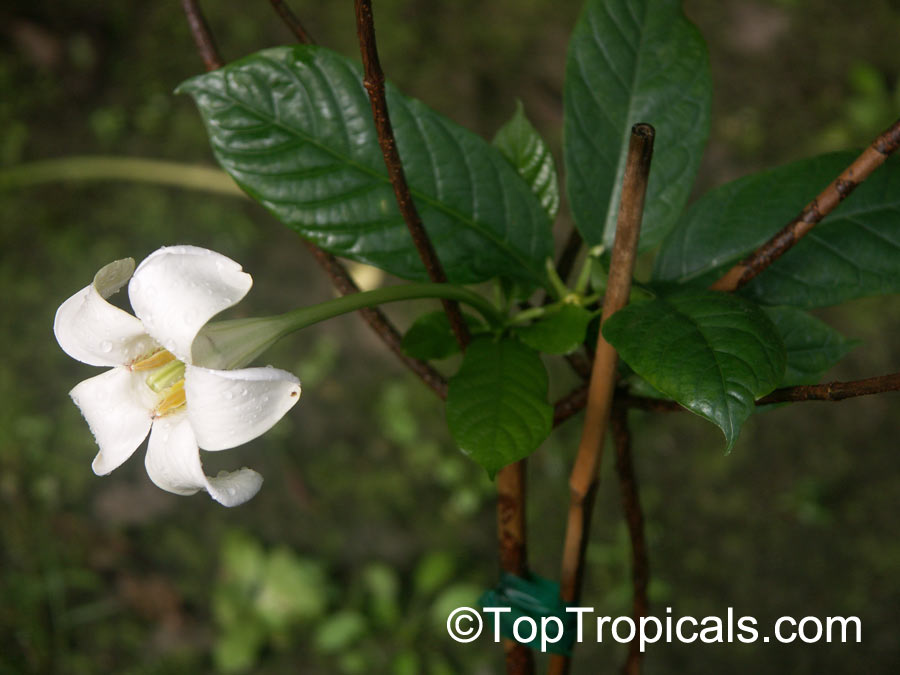
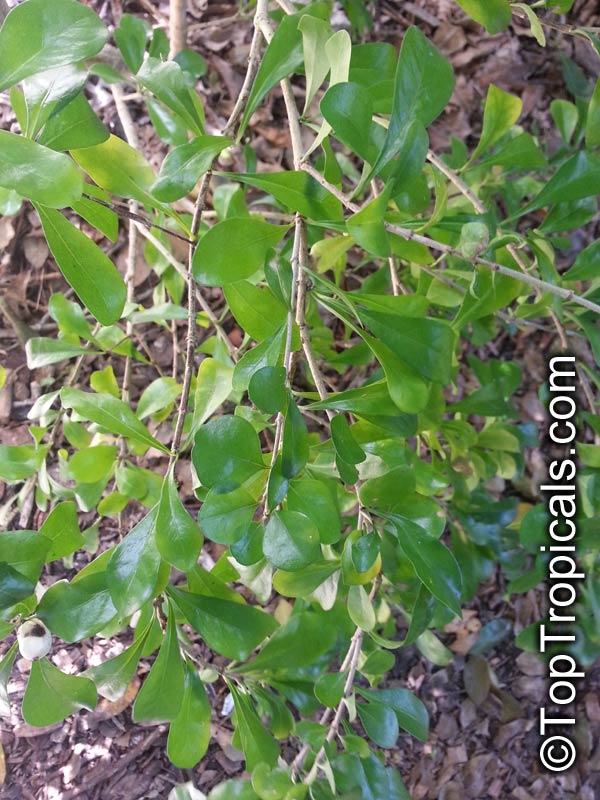
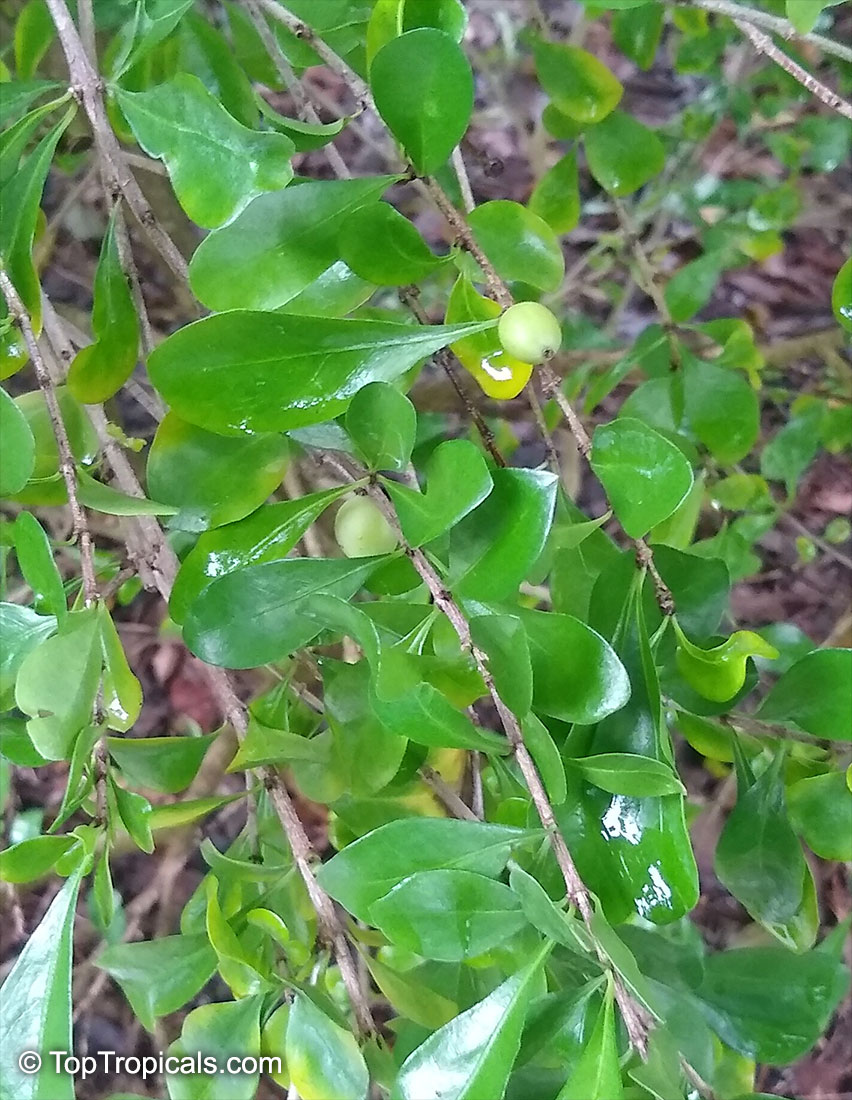
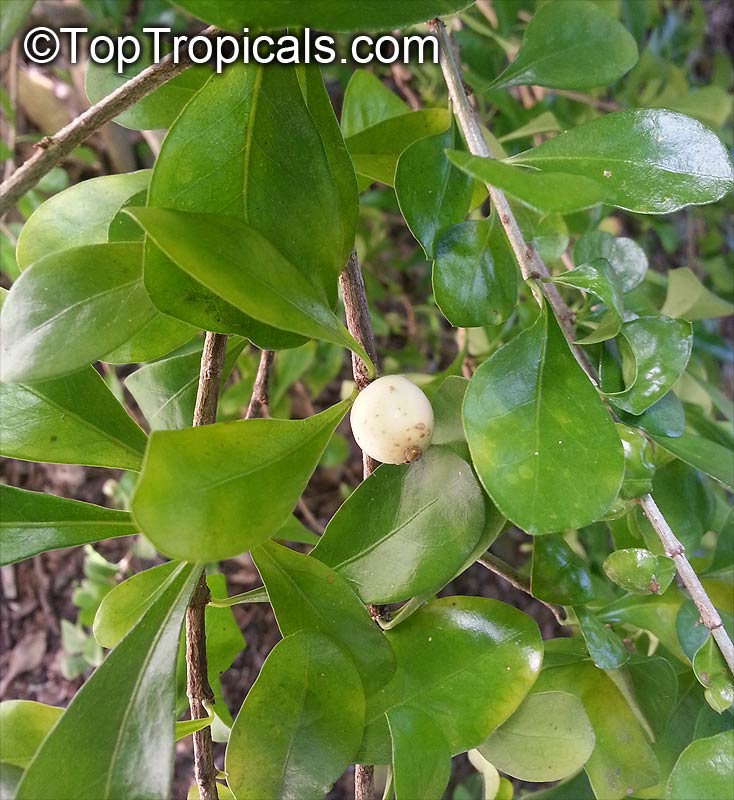
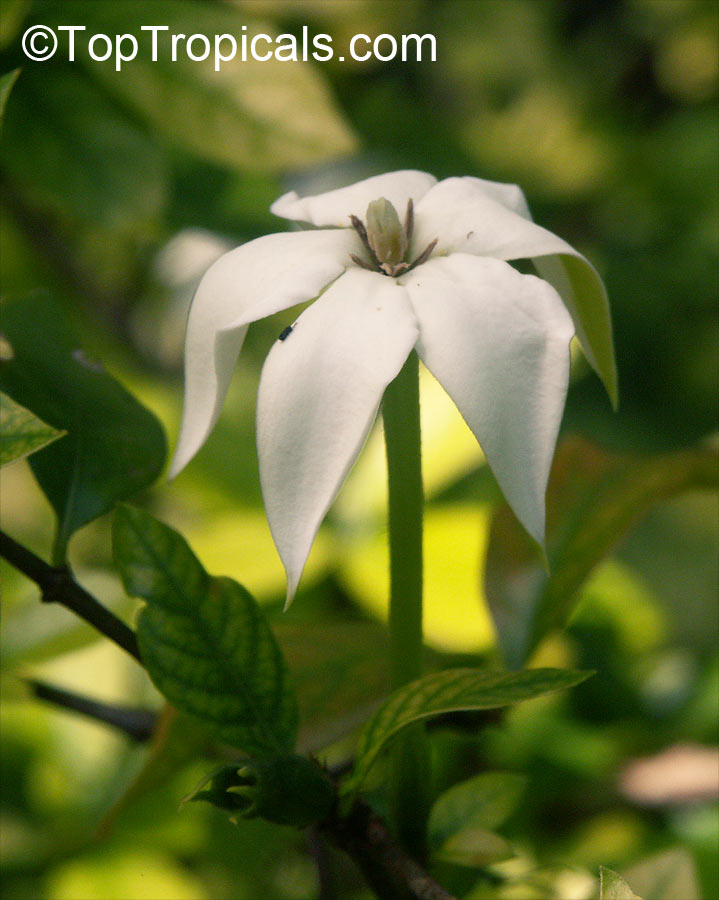
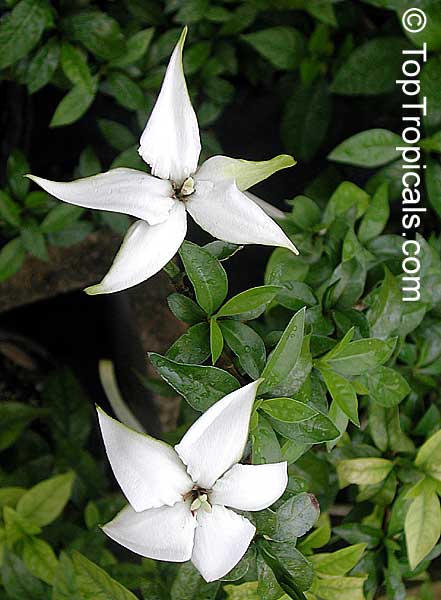

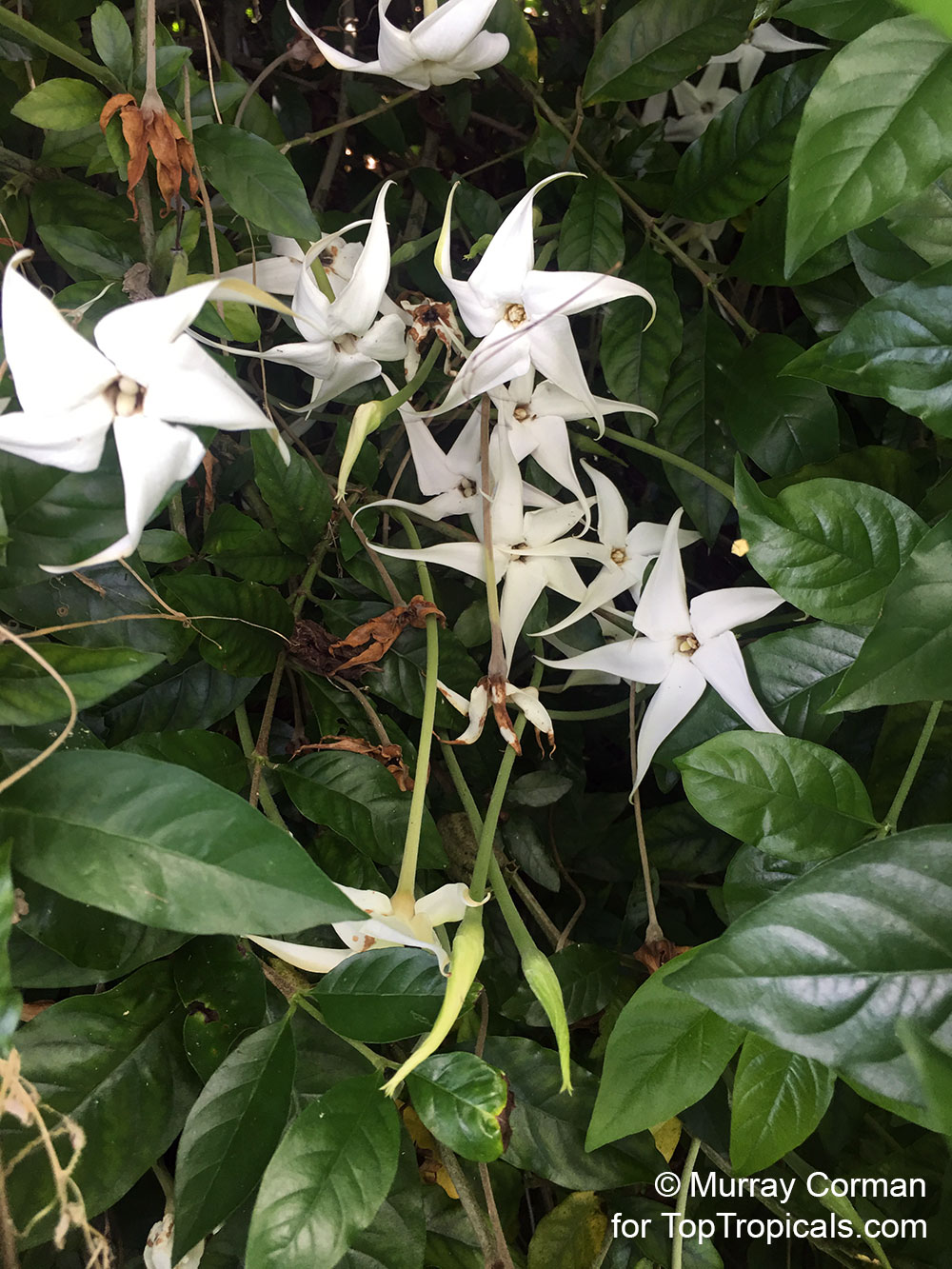
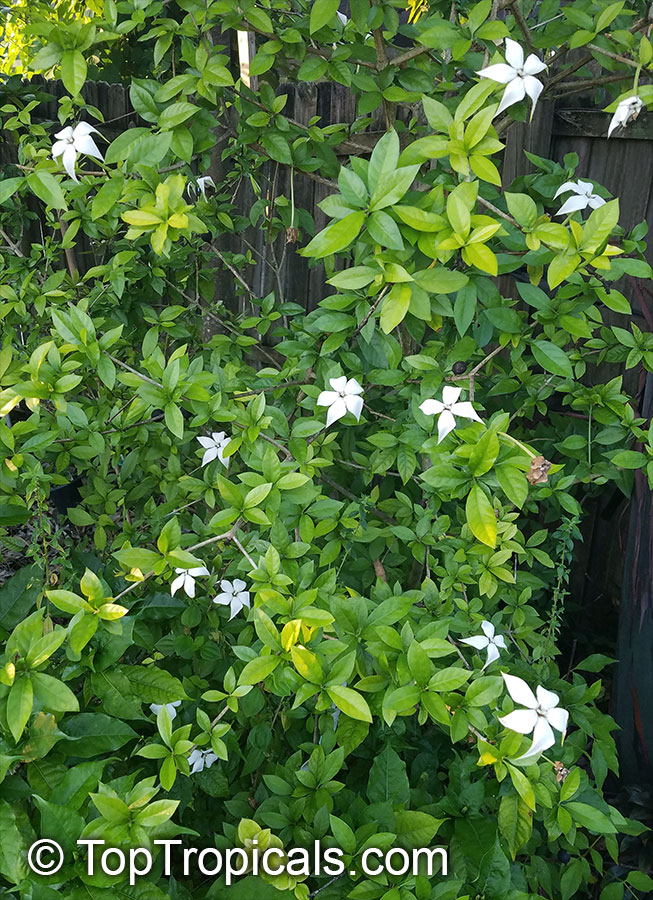
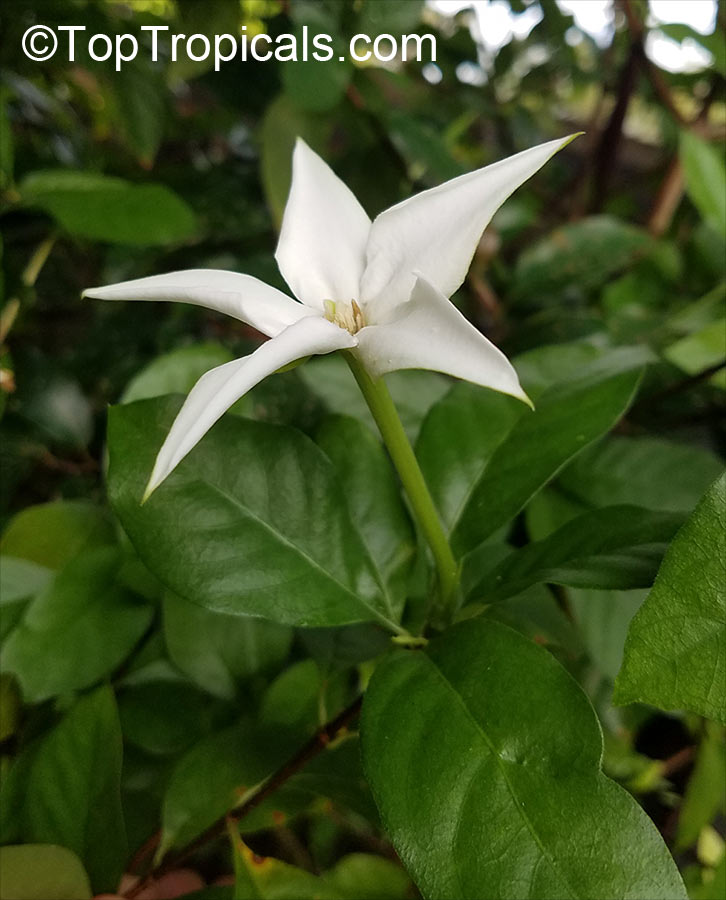
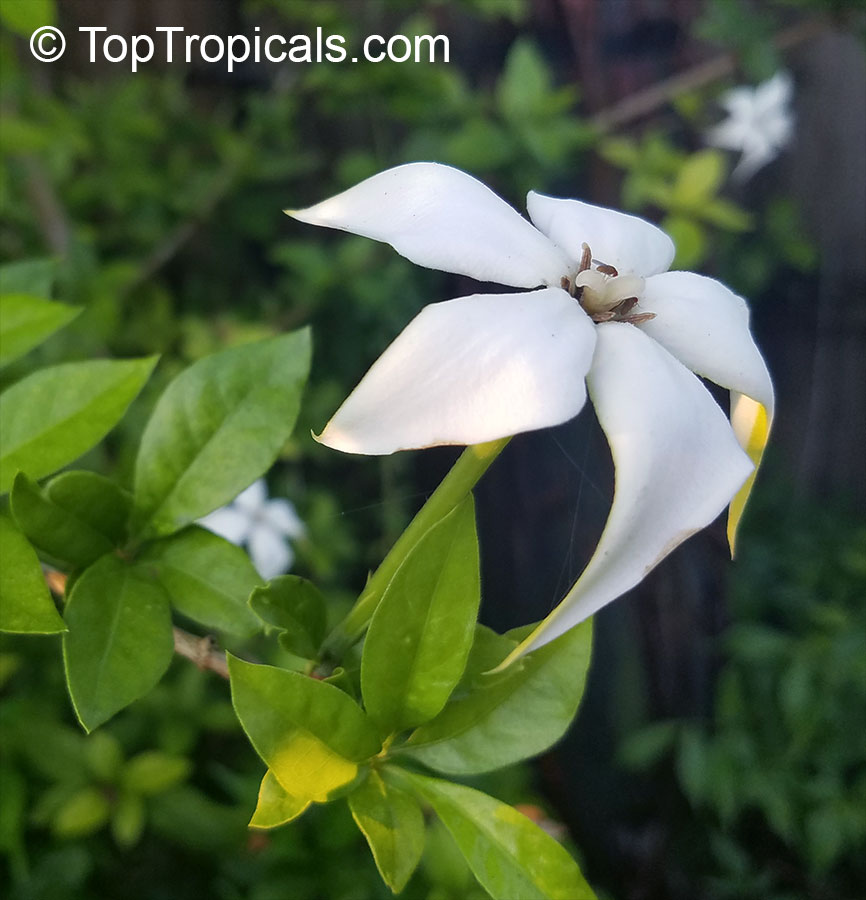
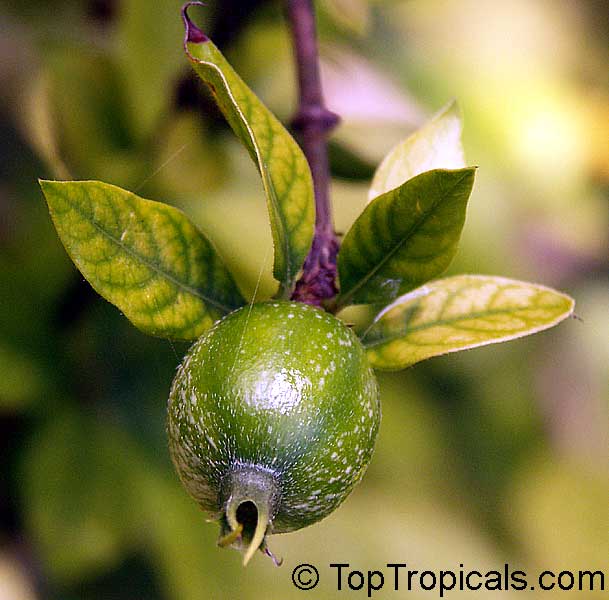
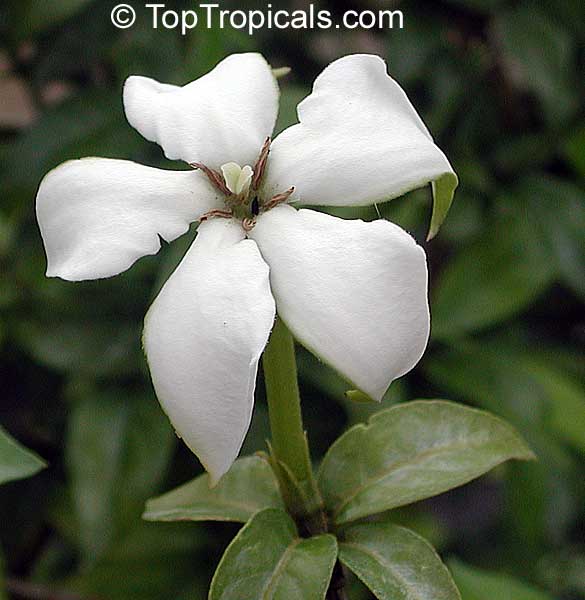
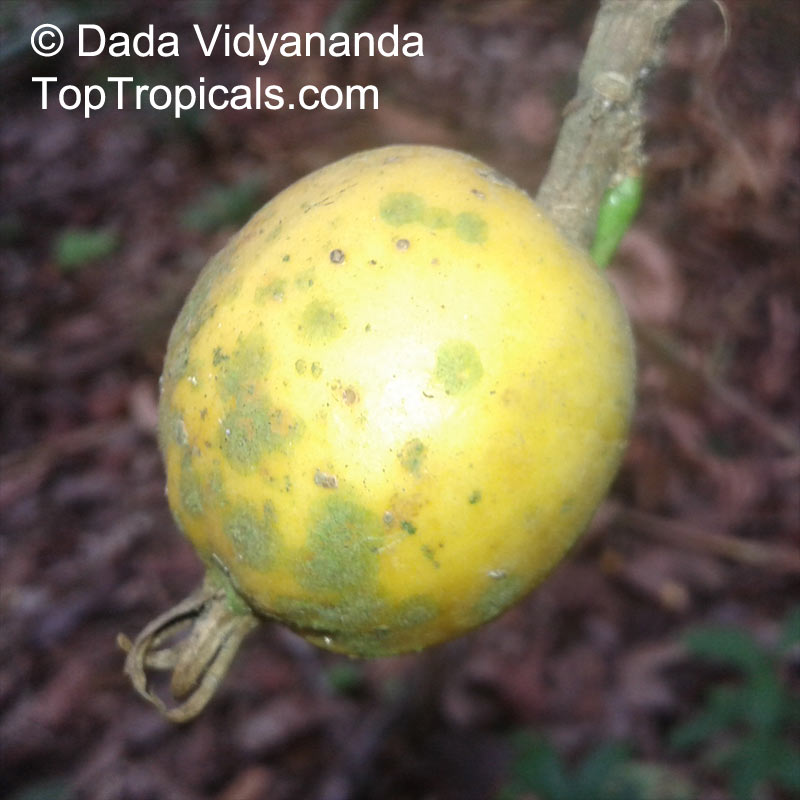
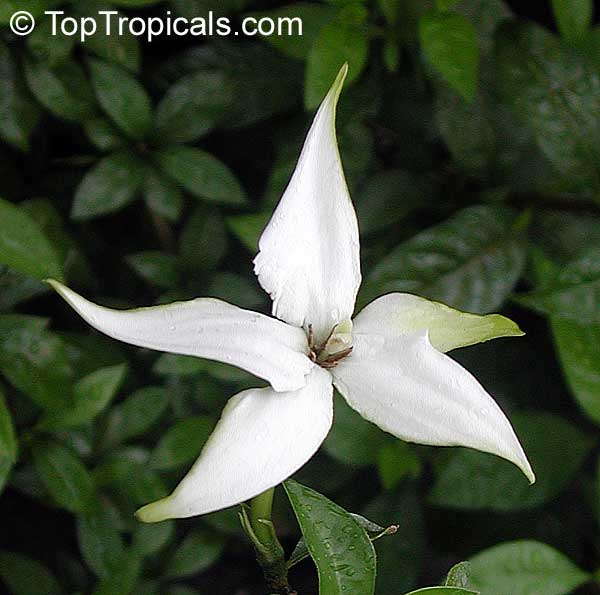

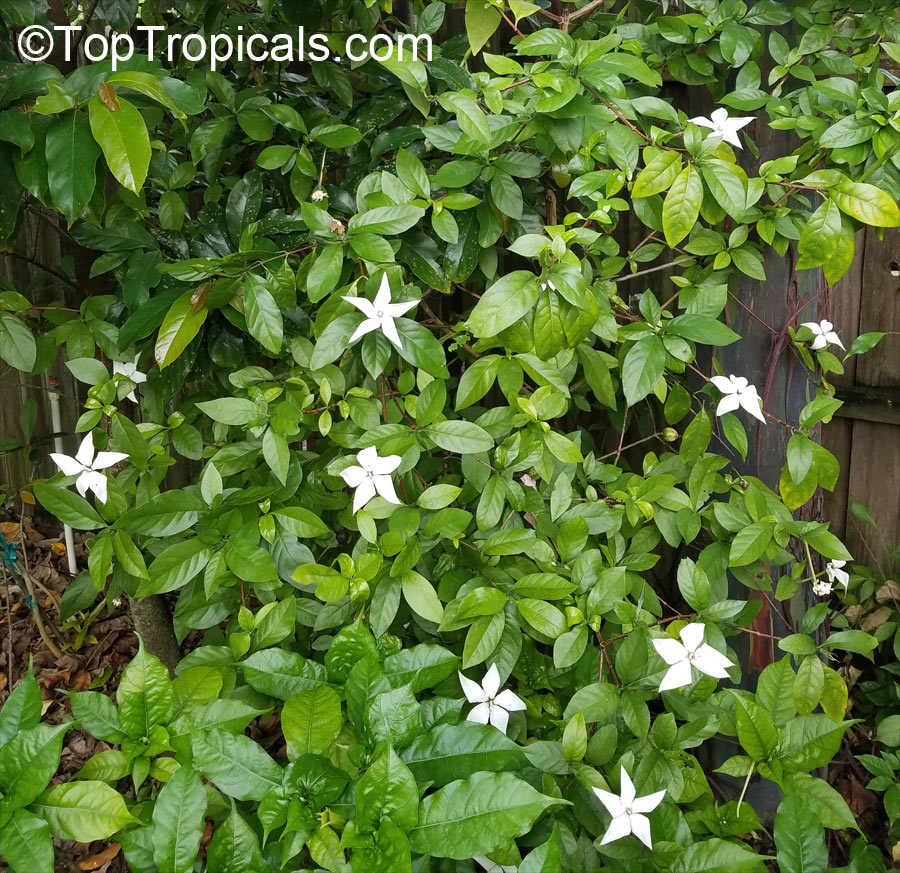
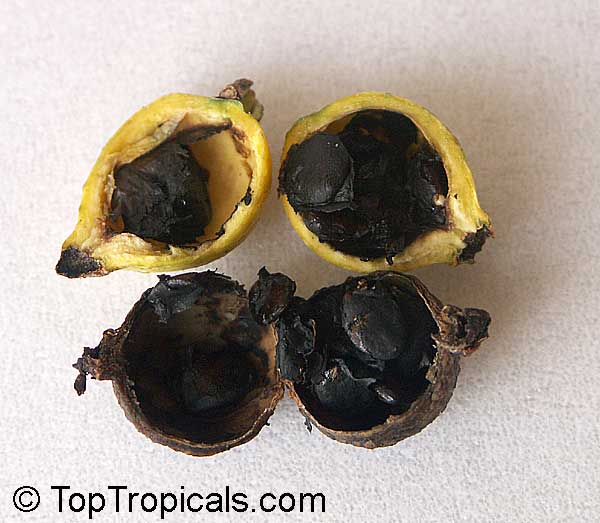
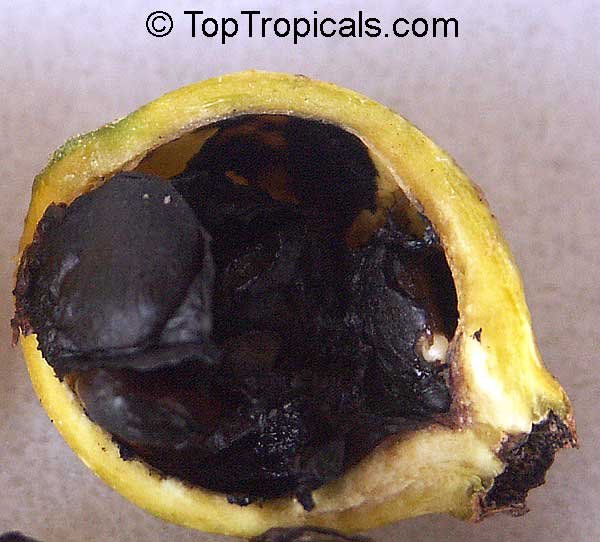
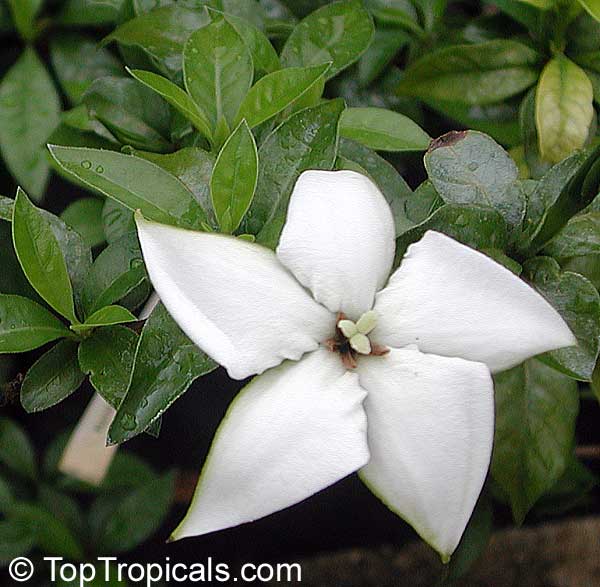
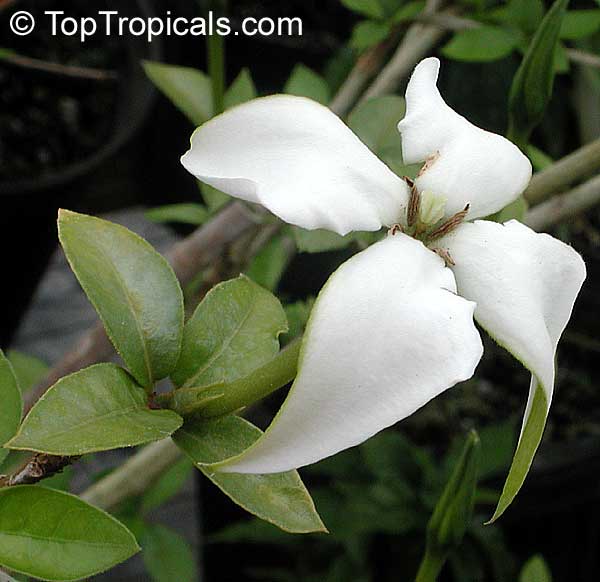
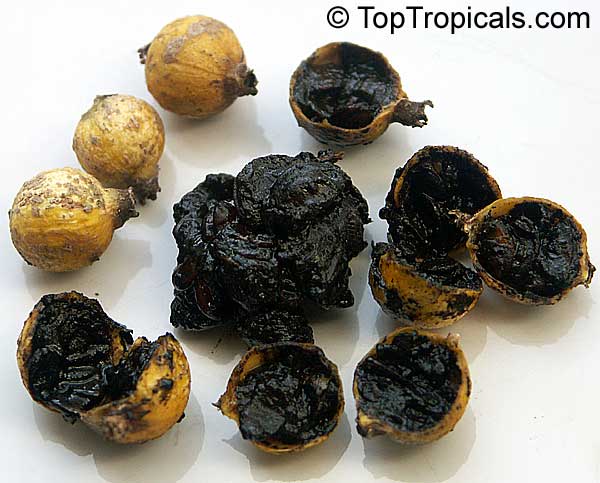
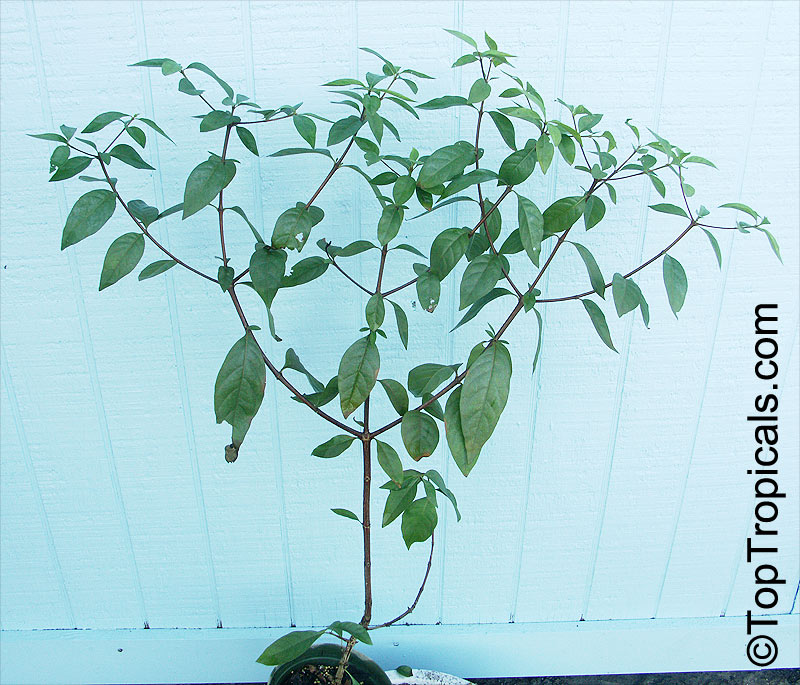
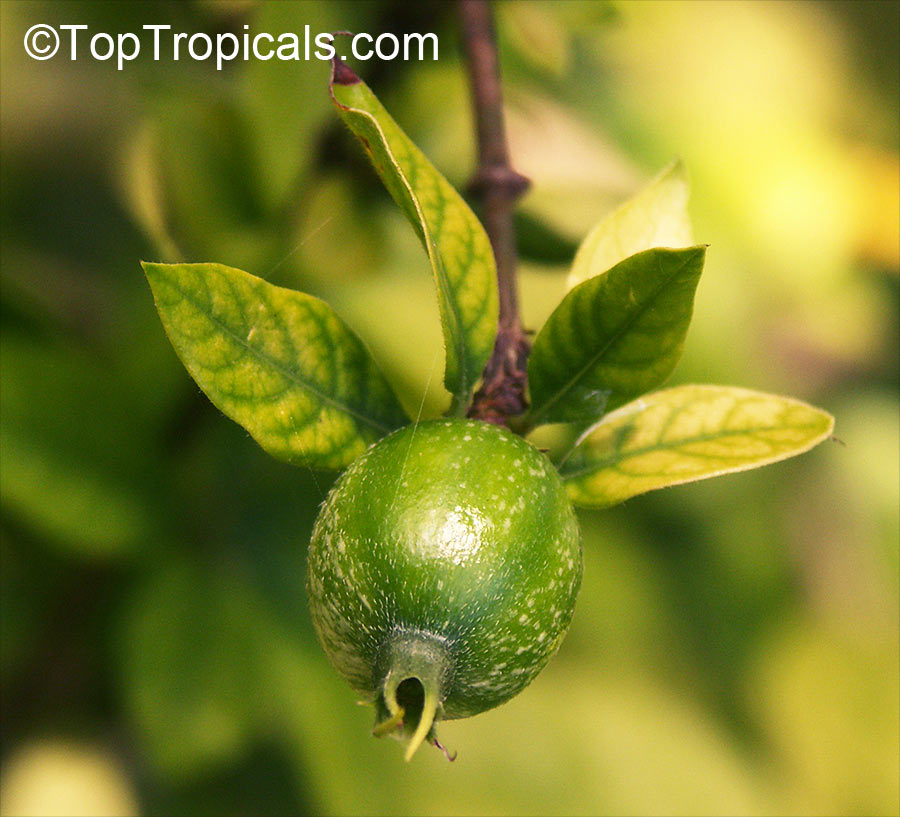
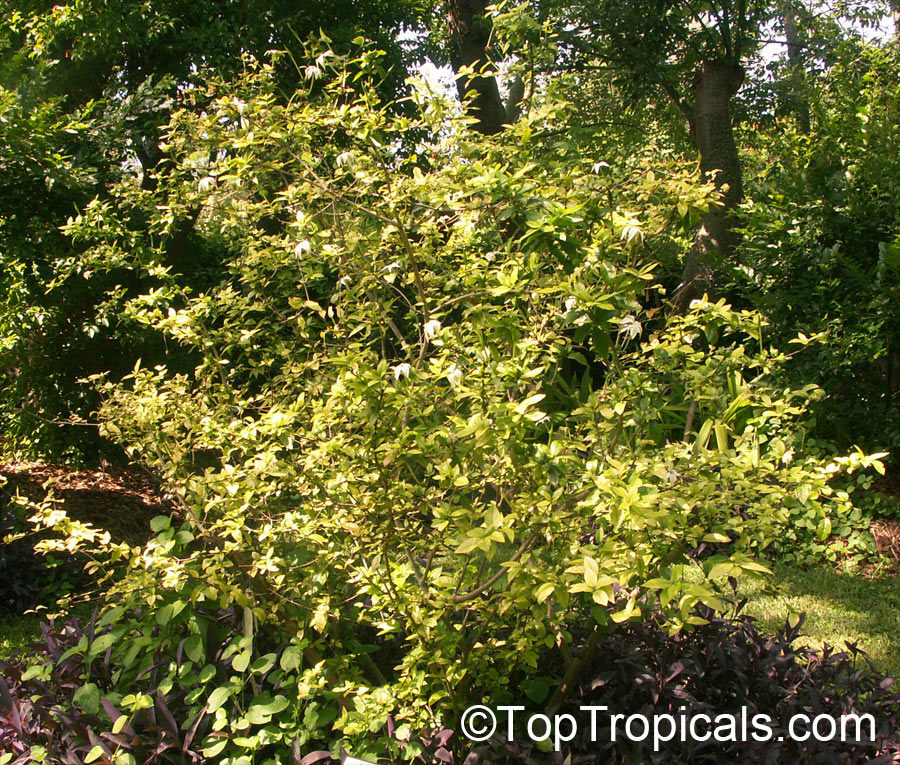
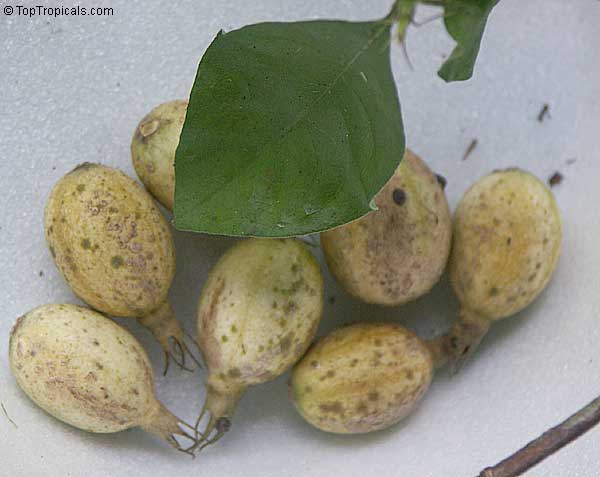
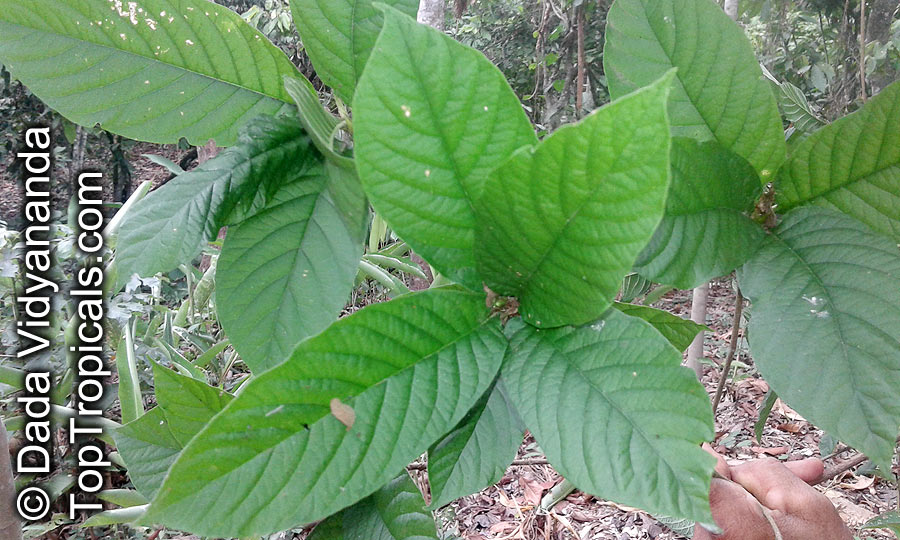
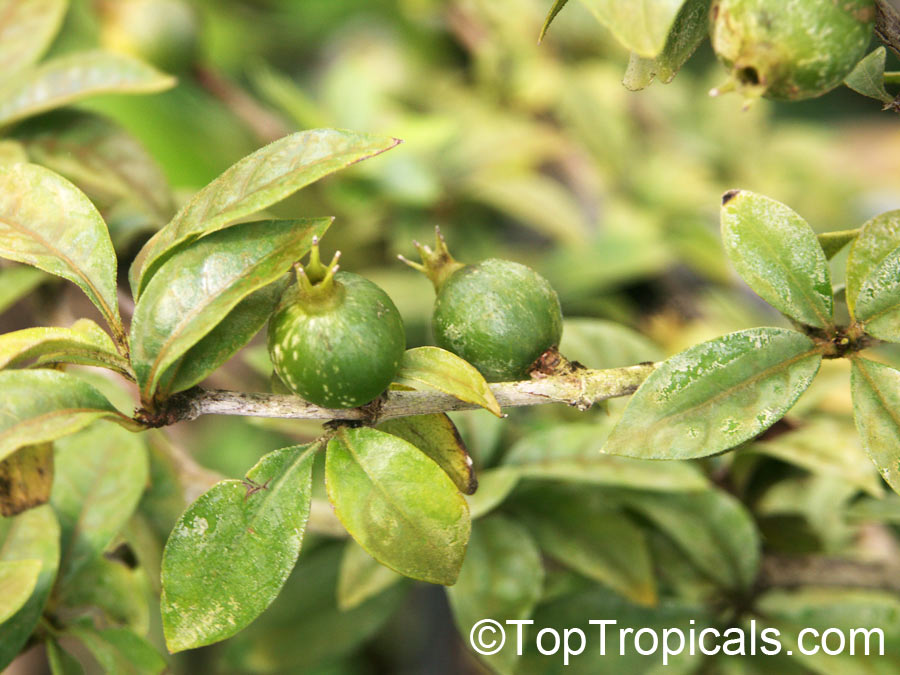
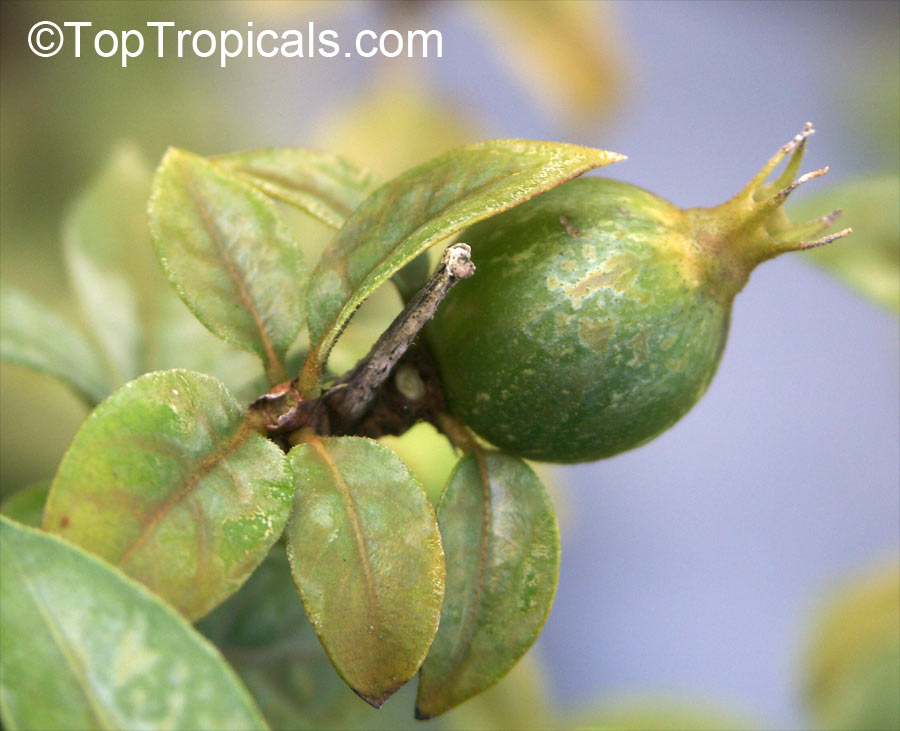
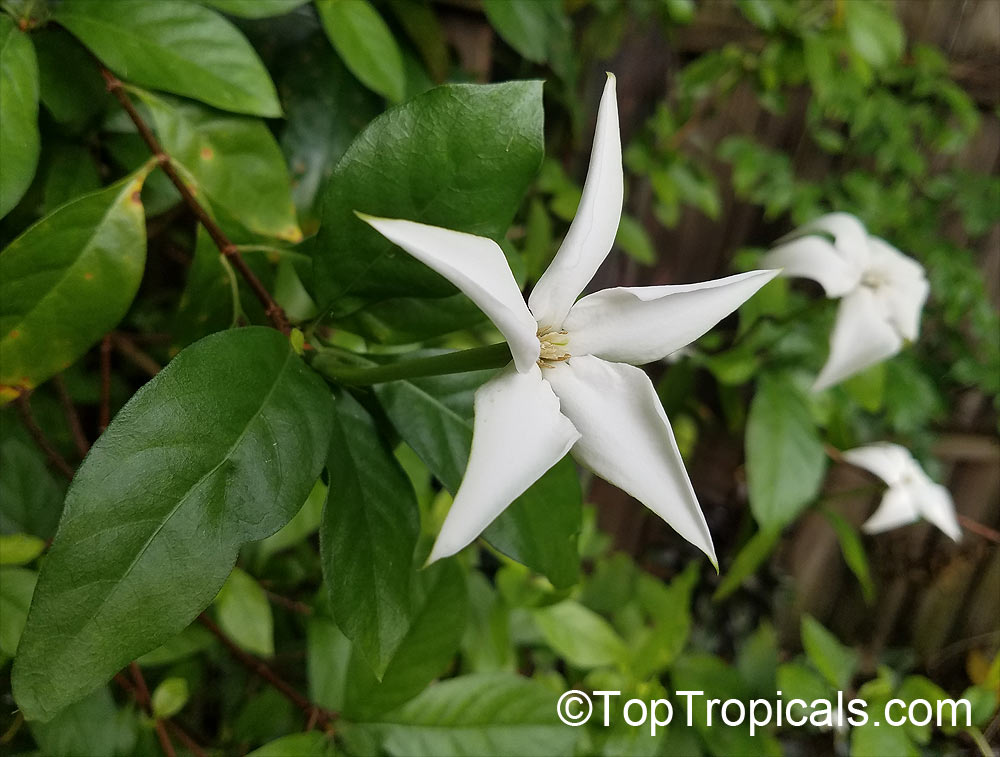
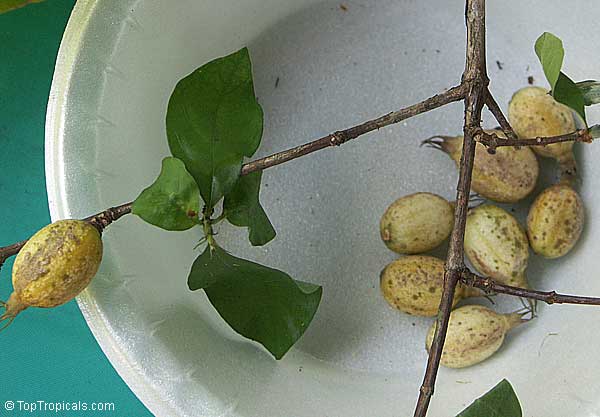
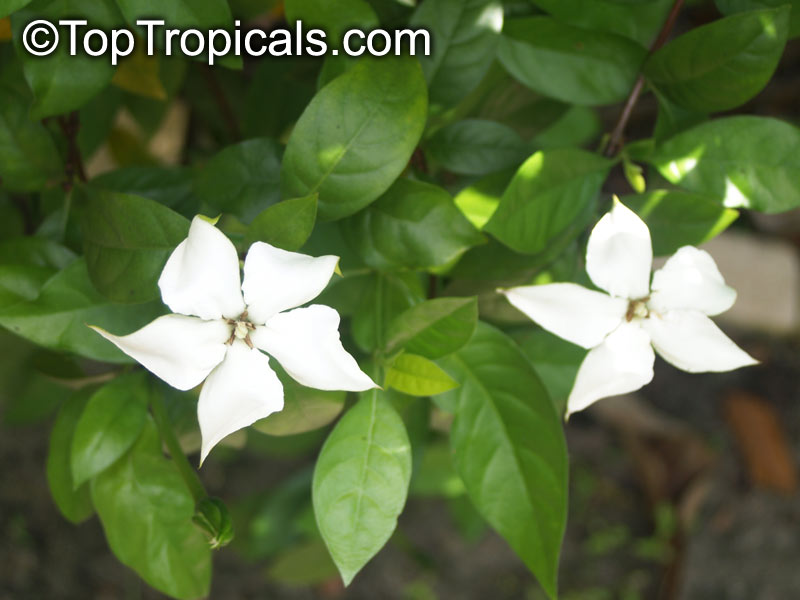
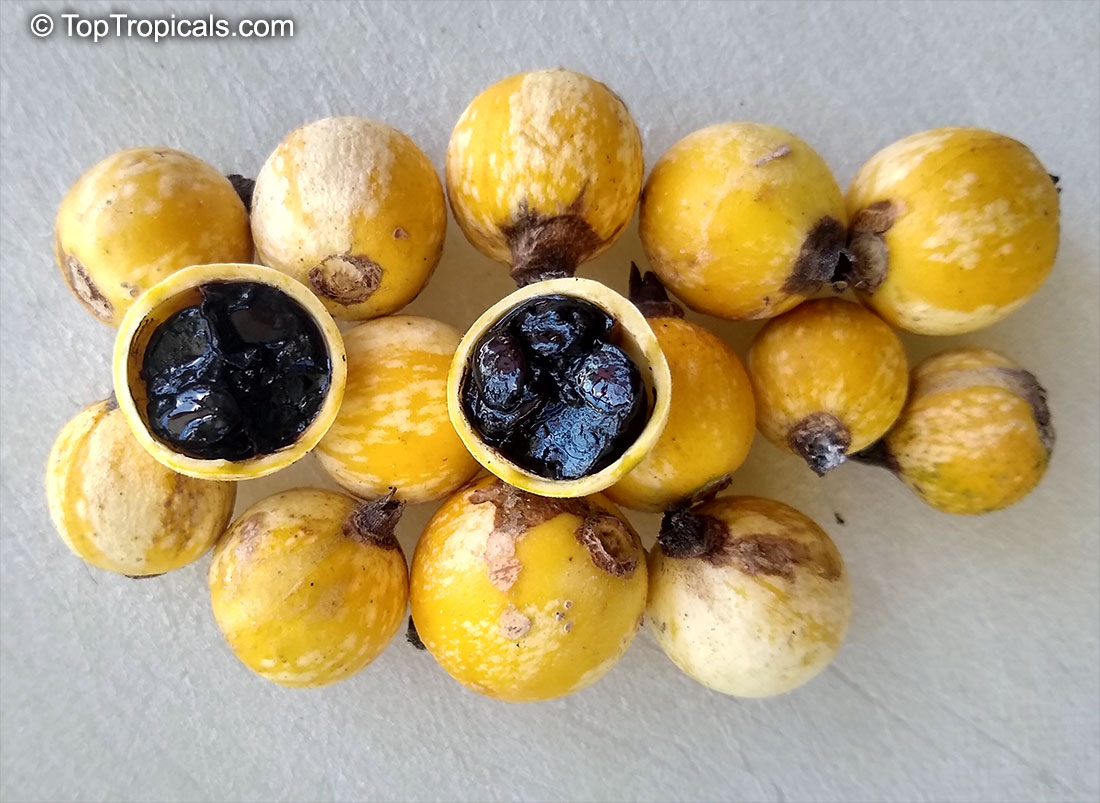
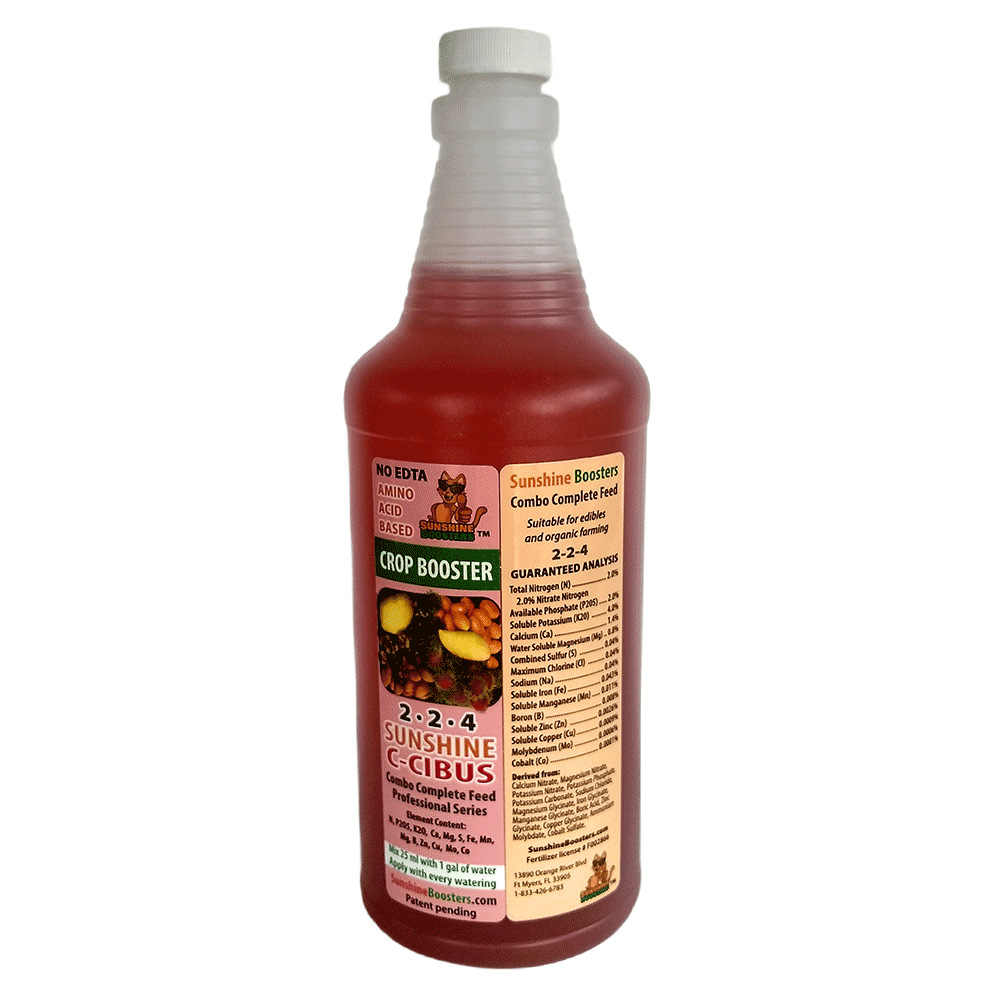 SUNSHINE C-Cibus (NPK 2-2-4) - Crop Booster for every watering.
SUNSHINE C-Cibus (NPK 2-2-4) - Crop Booster for every watering. 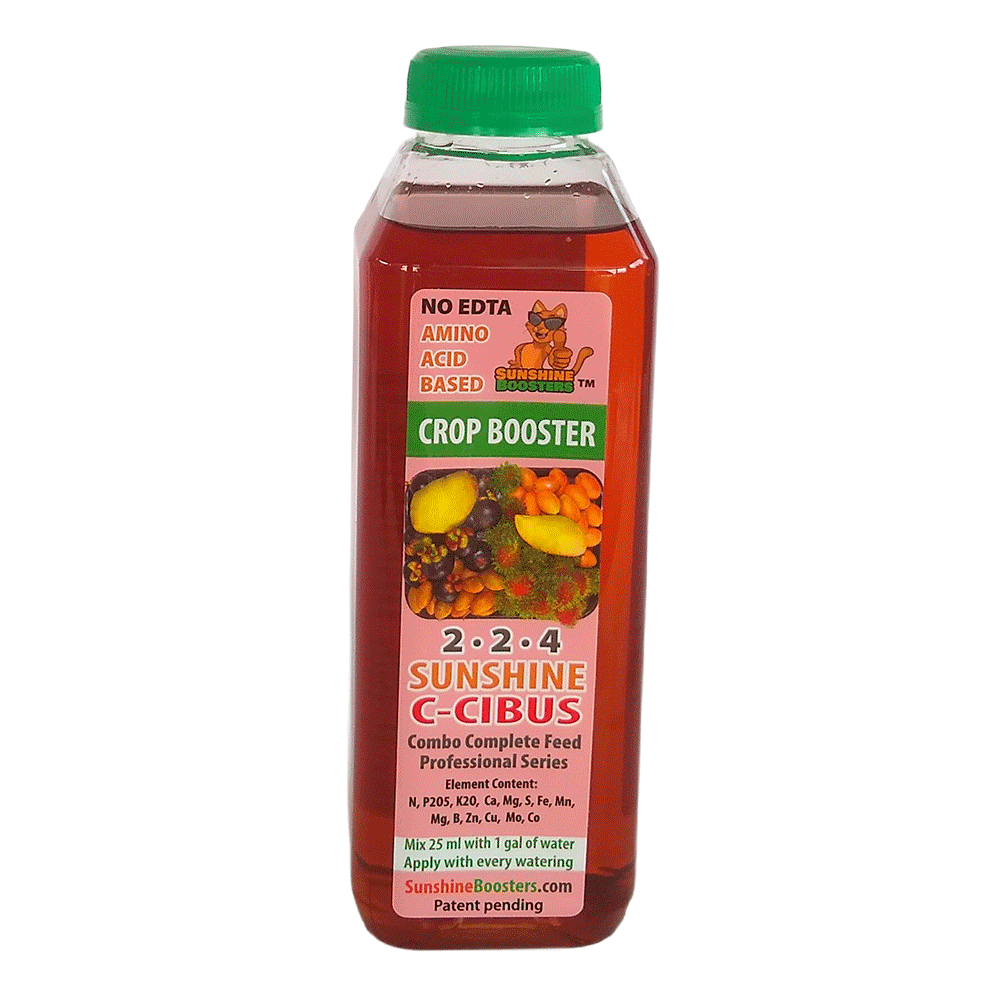 SUNSHINE C-Cibus (NPK 2-2-4) - Crop Booster for every watering.
SUNSHINE C-Cibus (NPK 2-2-4) - Crop Booster for every watering. 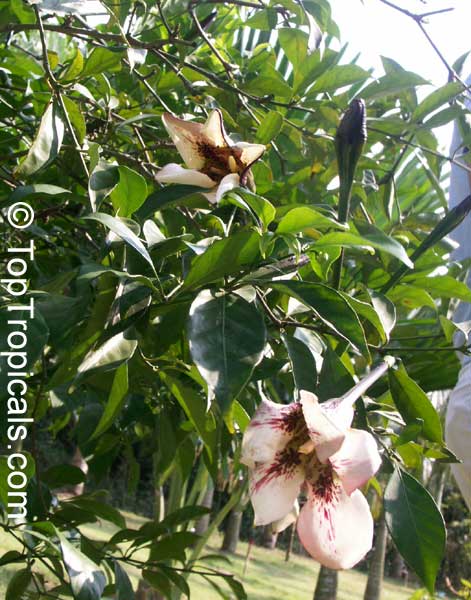
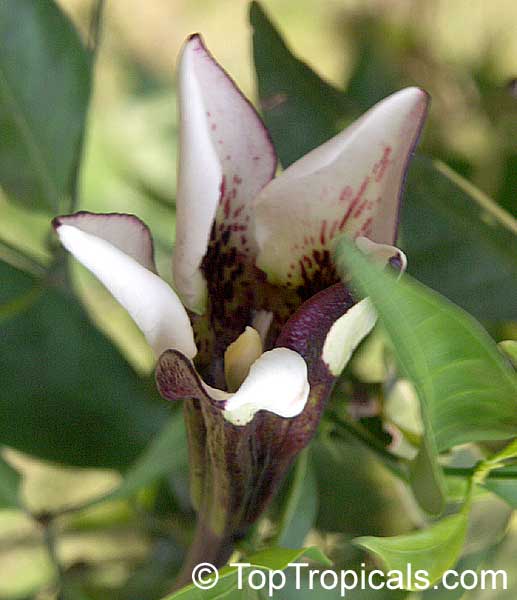
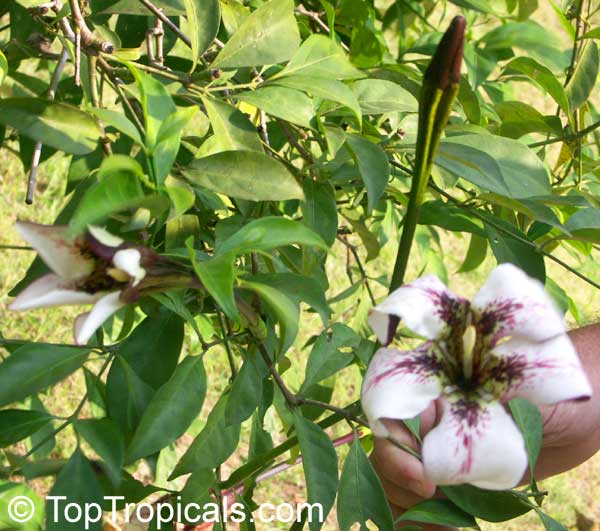
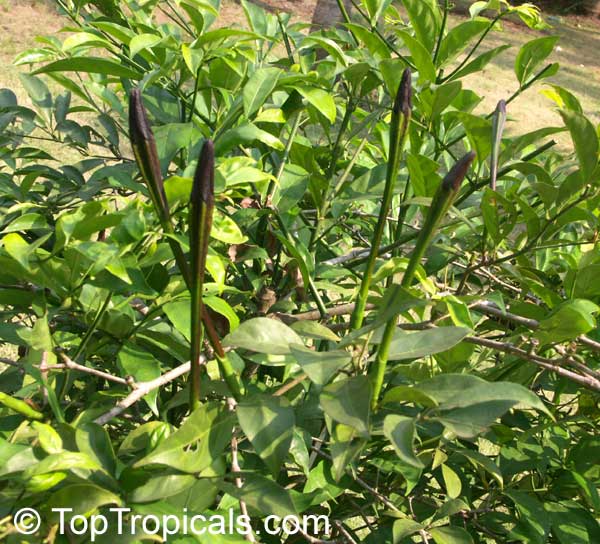
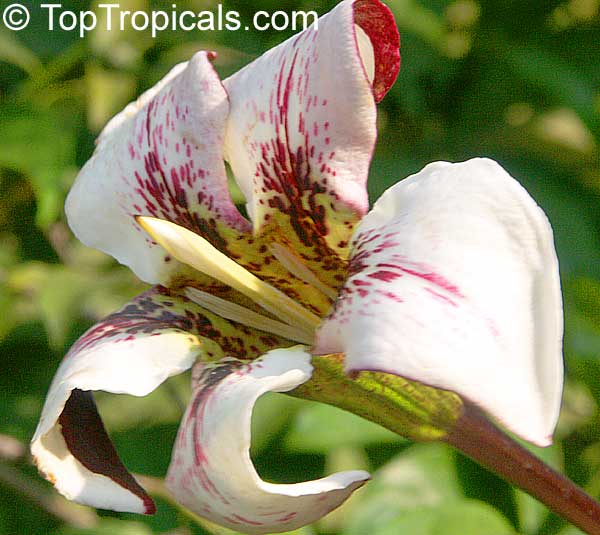
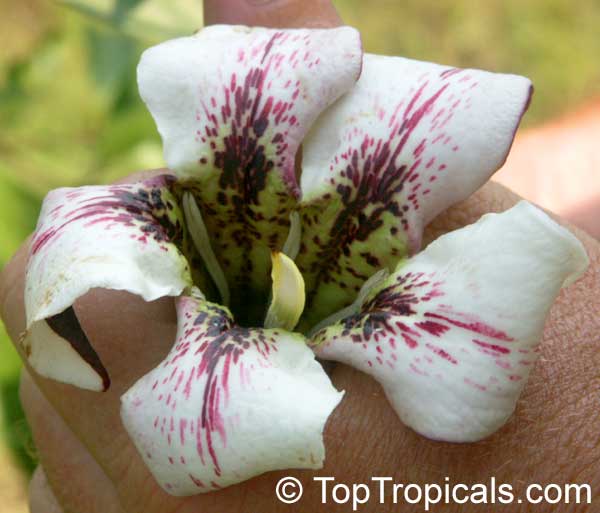

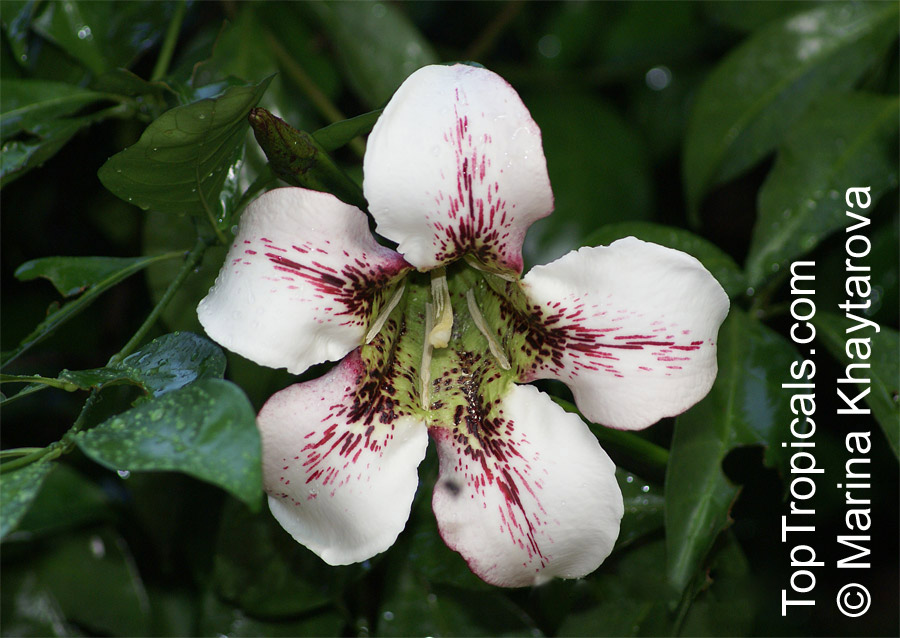
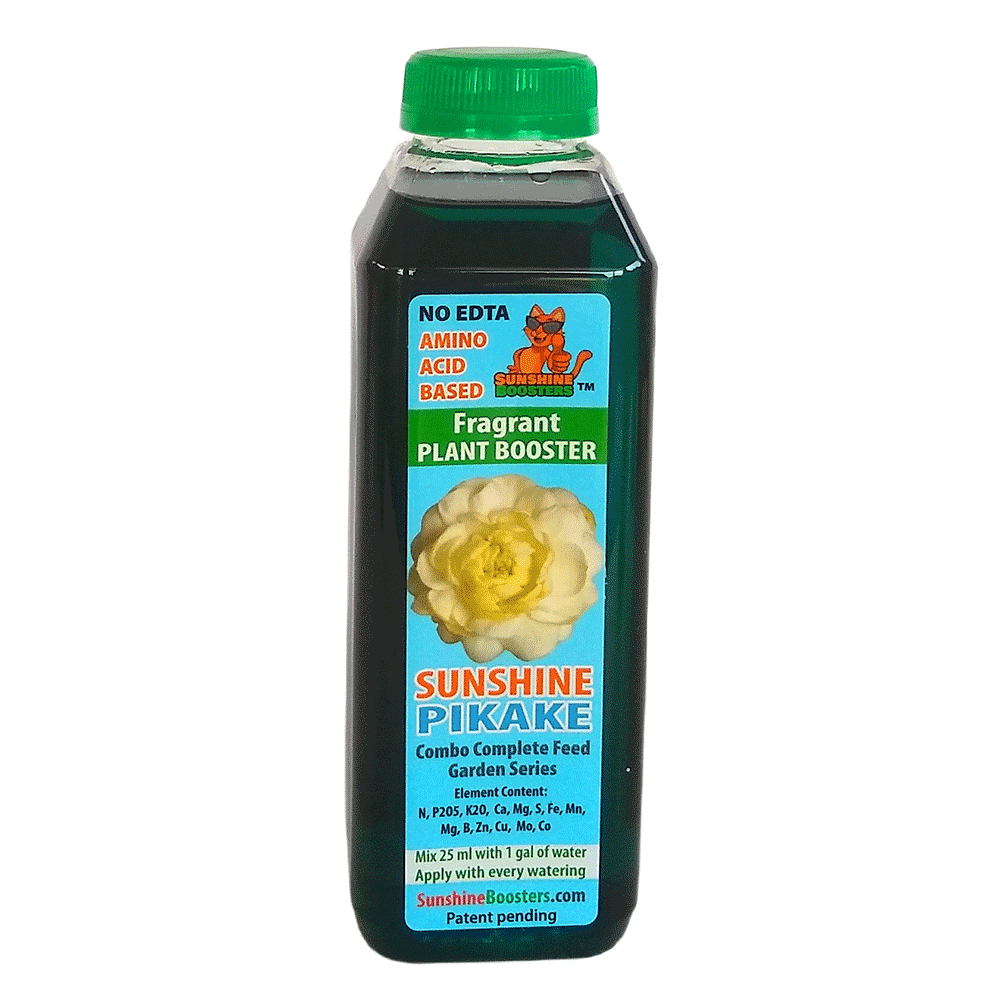 SUNSHINE Pikake (NPK 2-2-4) - eco-friendly concentrated nutrition booster for fragrant flowers. Improves quantity and quality of flowers. Encourages profuse blooming. Increases flower fragrance intensity. Can be used with every watering. For best results, use in combination with
SUNSHINE Pikake (NPK 2-2-4) - eco-friendly concentrated nutrition booster for fragrant flowers. Improves quantity and quality of flowers. Encourages profuse blooming. Increases flower fragrance intensity. Can be used with every watering. For best results, use in combination with 